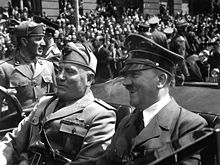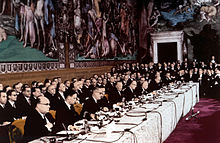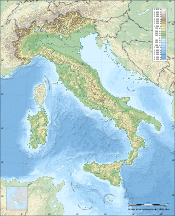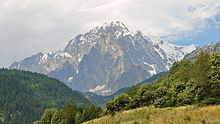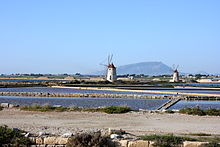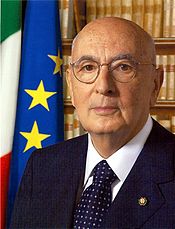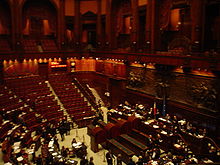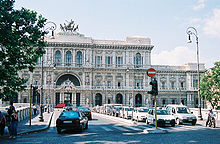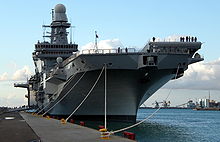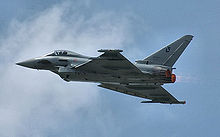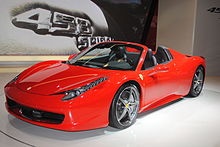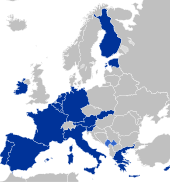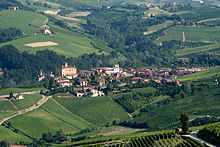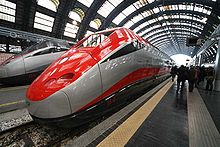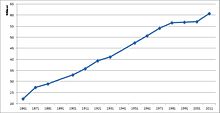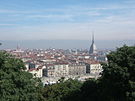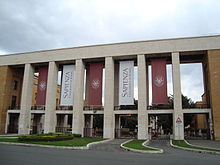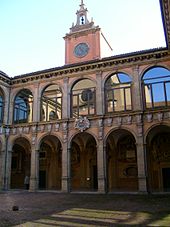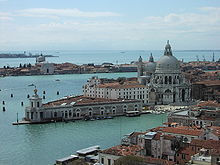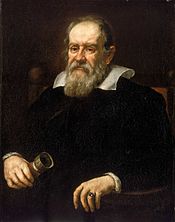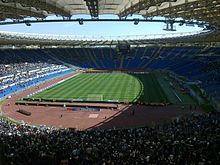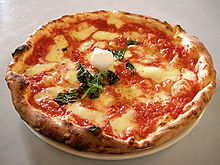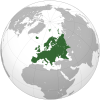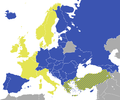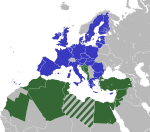- Italy
-
Italian Republic Repubblica italiana

Flag Emblem Anthem: Il Canto degli Italiani
The Song of the Italians
Location of Italy (dark green)– in Europe (green & dark grey)
– in the European Union (green) — [Legend]Capital
(and largest city)Rome
41°54′N 12°29′E / 41.9°N 12.483°EOfficial language(s) Italian[1] Demonym Italian Government Unitary parliamentary republic - President Giorgio Napolitano - Prime Minister Mario Monti Legislature Parliament - Upper House Senate of the Republic - Lower House Chamber of Deputies Formation - Unification 17 March 1861 - Republic 2 June 1946 Area - Total 301,338 km2 (71st)
116,346 sq mi- Water (%) 2.4 Population - April 2011 estimate 60,681,514 [2] (23rd) - 2001 census 56,995,744 - Density 201.2/km2 (61st)
521.2/sq miGDP (PPP) 2011 estimate - Total $1.828 trillion[3] (10th) - Per capita $30,165[3] (30th) GDP (nominal) 2011 estimate - Total $2.245 trillion[3] (8th) - Per capita $37,046[3] (24th) Gini (2006) 32[4] HDI (2011)  0.874[5] (very high) (24th)
0.874[5] (very high) (24th)Currency Euro (€)2 ( EUR)Time zone CET (UTC+1) - Summer (DST) CEST (UTC+2) Drives on the Right ISO 3166 code IT Internet TLD .it3 Calling code 394 1 French is co-official in the Aosta Valley; Slovene is co-official in the province of Trieste and the province of Gorizia; German and Ladin are co-official in the province of South Tyrol. 2 Before 2002, the Italian Lira. The euro is accepted in Campione d'Italia, but the official currency there is the Swiss Franc.[6] 3 The .eu domain is also used, as it is shared with other European Union member states. 4 To call Campione d'Italia, it is necessary to use the Swiss code +41. Italy
 i/ˈɪtəli/ (Italian: Italia [iˈtaːlja]), officially the Italian Republic (Italian: Repubblica italiana[note 1]), is a unitary parliamentary republic in South-Central Europe. To the north it borders France, Switzerland, Austria and Slovenia along the Alps. To the south it consists of the entirety of the Italian Peninsula, Sicily, Sardinia–the two largest islands in the Mediterranean Sea–and many other smaller islands. The independent states of San Marino and the Vatican City are enclaves within Italy, whilst Campione d'Italia is an Italian exclave in Switzerland. The territory of Italy covers some 301,338 km2 (116,347 sq mi) and is influenced by a temperate seasonal climate. With 60.6 million inhabitants, it is the fifth most populous country in Europe, and the 23rd most populous in the world.
i/ˈɪtəli/ (Italian: Italia [iˈtaːlja]), officially the Italian Republic (Italian: Repubblica italiana[note 1]), is a unitary parliamentary republic in South-Central Europe. To the north it borders France, Switzerland, Austria and Slovenia along the Alps. To the south it consists of the entirety of the Italian Peninsula, Sicily, Sardinia–the two largest islands in the Mediterranean Sea–and many other smaller islands. The independent states of San Marino and the Vatican City are enclaves within Italy, whilst Campione d'Italia is an Italian exclave in Switzerland. The territory of Italy covers some 301,338 km2 (116,347 sq mi) and is influenced by a temperate seasonal climate. With 60.6 million inhabitants, it is the fifth most populous country in Europe, and the 23rd most populous in the world.Rome, the capital of Italy, was for centuries the political and religious centre of Western civilisation as the capital of the Roman Empire and site of the Holy See. After the decline of the Roman Empire, Italy endured numerous invasions by foreign peoples, from Germanic tribes such as the Lombards and Ostrogoths, to the Byzantines and later, the Normans, among others. Centuries later, Italy became the birthplace of Maritime republics and the Renaissance,[7] an immensely fruitful intellectual movement that would prove to be integral in shaping the subsequent course of European thought.
Through much of its post-Roman history, Italy was fragmented into numerous kingdoms and city-states (such as the Kingdom of Sardinia, the Kingdom of the Two Sicilies and the Duchy of Milan), but was unified in 1861,[8] following a tumultuous period in history known as "Il Risorgimento" ("The Resurgence"). In the late 19th century, through World War I, and to World War II, Italy possessed a colonial empire, which extended its rule to Libya, Eritrea, Somalia, Ethiopia, Albania, the Dodecanese and a concession in Tianjin, China.[9]
Modern Italy is a democratic republic. It has been ranked the world's 24th most-developed country[10] and its Quality-of-life index has been ranked in the top ten in the world.[11] Italy enjoys a very high standard of living, and has a high nominal GDP per capita.[12][13] It is a founding member of what is now the European Union and part of the Eurozone. Italy is also a member of the G8, G20 and NATO. It has the world's third-largest gold reserves, eighth-largest nominal GDP, tenth highest GDP (PPP)[14] and the sixth highest government budget in the world.[15] It is also a member state of the Organisation for Economic Co-operation and Development, the World Trade Organization, the Council of Europe, the Western European Union and the United Nations. Italy has the world's ninth-largest defence budget and shares NATO's nuclear weapons.
Italy plays a prominent role in European and global military, cultural and diplomatic affairs. The country's European political, social and economic influence make it a major regional power.[16][17] The country has a high public education level and is a highly globalised nation.[18]
Contents
Etymology
The assumptions on the etymology of the name "Italia" are very numerous and the corpus of the solutions proposed by historians and linguists is very wide.[19] According to one of the more common explanations, the term Italia, from Latin: Italia,[20] was borrowed through Greek from the Oscan Víteliú, meaning "land of young cattle" (cf. Lat vitulus "calf", Umb vitlo "calf").[21] The bull was a symbol of the southern Italian tribes and was often depicted goring the Roman wolf as a defiant symbol of free Italy during the Samnite Wars. Greek historian Dionysius of Halicarnassus states this account together with the legend that Italy was named after Italus,[22] mentioned also by Aristotle[23] and Thucydides.[24]
The name Italia originally applied only to a part of what is now Southern Italy–according to Antiochus of Syracuse, the southern portion of the Bruttium peninsula (modern Calabria: province of Reggio, and part of the provinces of Catanzaro and Vibo Valentia). But by his time Oenotria and Italy had become synonymous, and the name also applied to most of Lucania as well. The Greeks gradually came to apply the name "Italia" to a larger region, but it was not until the time of the Roman conquests that the term was expanded to cover the entire peninsula.[25]
History
Prehistory and Antiquity
Excavations throughout Italy reveal a modern human presence dating back to the Paleolithic period, some 200,000 years ago.[26] The Italic tribes of pre-Roman Italy, such as the Umbrians, the Latins (from which the Romans emerged), Volsci, Samnites, the Celts and the Ligures which inhabited northern Italy, and many others are most of Indo-European stock; main historic peoples of non-Indo-European heritage include the Etruscans, the Elymians and Sicani in Sicily and the prehistoric Sardinians.
Between the 17th to the 11th century BC Mycenaean Greeks established contacts with Italy[27][28][29][30][31][32][33] and in the 8th and 7th centuries BC Greek colonies were established all along the coast of Sicily and the southern part of the Italian Peninsula became known as Magna Graecia. Also the Phoenicians established colonies on the coasts of Sardinia and Sicily.
Ancient Rome was at first a small agricultural community founded c. the 8th century BC, that grew over the course of the centuries into a colossal empire encompassing the whole Mediterranean Sea, in which Ancient Greek and Roman cultures merged into one civilization. This civilization was so influential that parts of it survive in modern law, administration, philosophy and arts, forming the ground that Western civilization is based upon. In a slow decline since the late 4th century AD, the empire finally broke into two parts in 395 AD: the Western Roman Empire and the Eastern Roman Empire. The western part, under the pressure of the Franks, the Vandals, the Huns, the Goths and other populations from Eastern Europe, finally dissolved, leaving the Italian peninsula divided into small independent kingdoms and feuding city states for the next 1,300 years. The eastern part became to sole heir to the Roman legacy.
Middle Ages
 Italy's Naval Jack, featuring the coats of arms of the four major Maritime Republics. Clockwise from upper left: Venice, Genoa, Pisa, Amalfi.
Italy's Naval Jack, featuring the coats of arms of the four major Maritime Republics. Clockwise from upper left: Venice, Genoa, Pisa, Amalfi.
In the 6th century the Byzantine Emperor Justinian I reconquered Italy from the Ostrogoths. The invasion of a new wave of Germanic tribes and the Lombards late in the same century reduced the Byzantine presence to the Exarchate of Ravenna and other lands in southern Italy.
The Lombard reign of northern and central Italy was absorbed into the Frankish Empire by Charlemagne in the late 8th century. The Frankish kings also helped the formation of the Papal States in central Italy, extending from Rome to Ravenna, although for most of the Middle Ages the Papacy only effectively controlled Latium. Until the 13th century, Italian politics was dominated by the relationship between the German Holy Roman Emperors and the popes, with most of the Italian states siding for one or another depending from momentary convenience.
It was during this vacuum of authority that the region saw the rise of institutions such as the Signoria and the medieval commune. In the anarchic conditions that often prevailed in medieval Italian city-states, people looked to strong men to restore order and disarm the feuding elites. Despite the devastation of the numerous wars, Italy maintained, especially in the north, a relatively developed urban civilization, which later evolved in the peculiar phenomenon of its merchant Republics. These city-states, oligarchical in reality, had a dominant merchant class which under relative political freedom nurtured academic and artistic advancement. Notable amongst them, in northern Italy, was the Duchy of Milan: in the 12th century it led the Lombard League in the defeat of the German emperor Frederick Barbarossa, leading to a process granting effective independence to most of northern and central Italian cities.
During the same period, Italy saw the rise of numerous Maritime Republics, the most notable being Venice, Genoa, Pisa and Amalfi. These maritime republics were also heavily involved in the Crusades, taking advantage of political and trading opportunities. Venice and Genoa soon became Europe's main gateways to trade with the East, establishing colonies as far as the Black Sea and often controlling most of the trade with the Byzantine Empire and the Islamic Mediterranean world. The county of Savoy expanded its territory into the peninsula in the late Middle Ages, while Florence developed into a highly organized commercial and financial city, becoming for many centuries the European capital of silk, wool, banking and jewelry.
Sicily had become an Islamic emirate in the 9th century, thriving until the Italo-Normans conquered it in the late 11th century together with most of the Lombard and Byzantine states of southern Italy. Through a complex series of events, southern Italy remained an unified kingdom, first under the House of Hohenstaufen, then under the Capetian House of Anjou and, from the 15th century, the house of Aragon (although Sicily was separate, under Aragon, from the late 13th to the 15th century). In Sardinia, the former Byzantine provinces became independent states known as giudicati, although most of the island was under Genoese or Pisan control until the Aragonese conquered it in the 15th century.
Early Modern
The Black Death pandemic in 1348 left its mark on Italy by killing one third of the population.[34][35] However, the recovery from the disaster of the Black Death led to a resurgence of cities, trade and economy which greatly stimulated the successive phases of Humanism and Renaissance.
In the 14th and 15th centuries, Northern and upper Central Italy were divided into a number of warring city-states, the rest of the peninsula being occupied by the larger Papal States and Naples. Warfare between the states was common, invasion from outside Italy confined to intermittent sorties of Holy Roman Emperors. These wars were primarily fought by armies of mercenaries known as condottieri, bands of soldiers drawn from around Europe, but especially Germany and Switzerland, led largely by Italian captains.[36]
Decades of fighting eventually saw Florence, Milan and Venice emerge as the dominant players, that agreed to the Peace of Lodi in 1454, which saw relative calm brought to the region for the first time in centuries. This peace would hold for the next forty years, and Venice's unquestioned hegemony over the sea also led to unprecedented peace for much of the rest of the 15th century. The Italian Renaissance peaked in the mid-16th century as foreign invasions plunged the region into the turmoil of the Italian Wars. However, the ideas and ideals of the Renaissance endured and even spread into the rest of Europe, setting off the Northern Renaissance, and the English Renaissance.
Following the Italian Wars (1494 to 1559), Italy saw a long period of relative peace, first under Habsburg Spain (1559 to 1713) and then under Habsburg Austria (1713 to 1796). The plague repeatedly returned to haunt Italy throughout the 14th to 17th centuries. In the first half of the 17th century a plague claimed some 1.7 million victims, or about 14% of Italy’s population.[37] As Spain declined in the 17th century, so did its Italian possessions in Naples, Sicily, Sardinia, and Milan. Southern Italy was impoverished, stagnant, and cut off from the mainstream of events in Europe.[38]
In the 18th century, as a result of the War of Spanish Succession, Austria replaced Spain as the dominant foreign power, while the House of Savoy emerged as a major regional power expanding to Piedmont and Sardinia. During the Napoleonic Wars, the northern part of the country was invaded and reorganized as a new Kingdom of Italy, essentially a client state of the French Empire,[39] while the southern half of the peninsula was administered by Joachim Murat, Napoleon's brother in law, who was crowned as King of Naples. The 1814 Congress of Vienna restored the situation of the late 18th century.
Italian unification and Liberal Italy
The creation of the Kingdom of Italy was the result of efforts by Italian nationalists and monarchists loyal to the House of Savoy to establish a united state encompassing the entire Italian Peninsula. In the context of the 1848 liberal revolutions that swept through Europe, an unsuccessful war was declared on Austria. The Kingdom of Sardinia again attacked the Austrian Empire in the Second Italian War of Independence of 1859, with the aid of France, resulting in liberating Lombardy. In 1860-61, Giuseppe Garibaldi led the drive for unification in Naples and Sicily,[40] allowing the Sardinian government led by the Count of Cavour to declare a united Italian kingdom on 17 March 1861. In 1866, Victor Emmanuel II allied with Prussia during the Austro-Prussian War, waging the Third Italian War of Independence which allowed Italy to annex Venetia. Finally, as France during the disastrous Franco-Prussian War of 1870 abandoned its garrisons in Rome, the Savoy rushed to fill the power gap by taking over the Papal States.
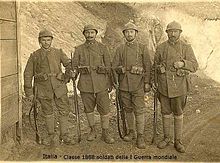 Italian infantrymen in 1916. More than 650,000 Italian soldiers lost their lives on the battlefields of World War I.
Italian infantrymen in 1916. More than 650,000 Italian soldiers lost their lives on the battlefields of World War I.
The Sardinian Albertine Statute of 1848, extended to the whole Kingdom of Italy in 1861, provided for basic freedoms, but electoral laws excluded the non-propertied and uneducated classes from voting. The government of the new kingdom took place in a framework of parliamentary constitutional monarcy dominated by liberal forces. In 1913, male universal suffrage was adopted. As Northern Italy quickly industrialized, the South and rural areas of North remained underdeveloped and overpopulated, forcing millions of people to migrate abroad, while the Italian Socialist Party constantly increased in strength, challenging the traditional liberal and conservative establishment.
Starting from the last two decades of the 19th century, Italy developed into a colonial power by forcing Somalia, Eritrea and later Libya and the Dodecanese under its rule.[41] During World War I, Italy at first stayed neutral but in 1915 signed the Treaty of London, entering the Entente on the promise of receiving Trento, Trieste, Gorizia and Gradisca, Istria and northern Dalmatia from the Austro-Hungarian Empire, as well as parts of the Ottoman Empire. During the war, more than 650,000 Italian soldiers died,[42] and the economy collapsed. Under the Peace Treaties of Saint-Germain, Rapallo and Rome, Italy obtained most of the promised territories, including the Croatian town of Fiume. Nevertheless, the victory was described as "mutilated" by the nationalists, since most of Dalmatia was assigned to the new Kingdom of Yugoslavia.
Fascist regime
The turbulence that followed the devastation of World War I, inspired by the Russian Revolution, led to turmoil and anarchy. The liberal establishment, fearing a socialist revolution, started to endorse the small National Fascist Party, led by Benito Mussolini. In October 1922 the fascists attempted a coup (the "March on Rome"), supported by king Victor Emmanuel III. Over the next few years, Mussolini banned all political parties and curtailed personal liberties, thus forming a dictatorship. In 1935, Mussolini invaded Ethiopia, resulting in an international alienation and leading to Italy's withdrawal from the League of Nations. Consequently, Italy allied with Nazi Germany and Empire of Japan and strongly supported Franco in the Spanish civil war. In 1939, Italy occupied Albania, a de facto protectorate for decades, and entered World War II in 1940 on the side of the Axis powers. Mussolini, wanting a quick victory like Hitler's Blitzkriegs in Poland and France, invaded Greece in October 1940 but was forced to accept a humiliating stalemate after a few months. At the same time, Italy, after initially conquering British Somalia and parts of Egypt, saw an allied counter-attack lead to the loss of all possessions in the Horn of Africa and in North Africa.
Italy was then invaded by the Allies in July 1943, leading to the collapse of the Fascist regime and the fall of Mussolini. In September 1943, Italy surrendered. The country remained a battlefield for the rest of the war, as the allies were moving up from the south as the north was the base for loyalist Italian fascist and German Nazi forces, fought also by the Italian resistance movement. The hostilities ended on 2 May 1945. Nearly half a million Italians (including civilians) died in the conflict,[43] and the Italian economy had been all but destroyed; per capita income in 1944 was at its lowest point since the beginning of the 20th century.[44]
Italian Republic
Italy became a republic after a referendum held on 2 June 1946, a day celebrated since as Republic Day. This was also the first time that Italian women were entitled to vote.[45] Victor Emmanuel III's son, Umberto II, was forced to abdicate and exiled. The Republican Constitution was approved on 1 January 1948. Under the Paris Peace Treaties of 1947, the eastern border area was lost to Yugoslavia, and, later, the Free Territory of Trieste was divided between the two states. Fears in the Italian electorate of a possible Communist takeover proved crucial for the first universal suffrage electoral outcome on 18 April 1948, when the Christian Democrats, under the leadership of Alcide De Gasperi, obtained a landslide victory. Consequently, in 1949 Italy became a member of NATO. The Marshall Plan helped to revive the Italian economy which, until the late 1960s, enjoyed a period of sustained economic growth commonly called the "Economic Miracle". In 1957, Italy was a founding member of the European Economic Community (EEC), which became the European Union (EU) in 1993.
From the late 1960s until the early 1980s, the country experienced the Years of Lead, a period characterized by economic crisis (especially after the 1973 oil crisis), widespread social conflicts and terrorist massacres carried out by opposing extremist groups, with the alleged involvement of US intelligence.[46][47][48] The Years of Lead culminated in the assassination of the Christian Democrat leader Aldo Moro in 1978, an event that deeply affected the whole country. In the 1980s, for the first time since 1945, two governments were led by non-Christian-Democrat premiers: one liberal (Giovanni Spadolini) and one socialist (Bettino Craxi); the Christian Democrats remained, however, the main government party. During Craxi's government, the economy recovered and Italy became the world's fifth largest industrial nation, gaining entry into the G7 Group. However, as a result of his spending policies, the Italian national debt skyrocketed during the Craxi era, soon passing 100% of the GDP.
In the early 1990s, Italy faced significant challenges, as voters, disenchanted with political paralysis, massive government debt and the extensive corruption system (known as Tangentopoli) uncovered by the 'Clean Hands' investigation, demanded radical reforms. The scandals involved all major parties, but especially those in the government coalition: the Christian Democrats, who ruled for almost 50 years, underwent a severe crisis and eventually disbanded, splitting up into several factions. The Communists reorganized as a social-democratic force. During the 1990s and the 2000s, centre-right (dominated by media magnate Silvio Berlusconi) and centre-left coalitions alternatively governed the country.
Geography
Italy is located in Southern Europe and comprises the boot-shaped Italian Peninsula and a number of islands including the two largest, Sicily and Sardinia. It lies between latitudes 35° and 47° N, and longitudes 6° and 19° E. Although the country comprises the Italian peninsula and most of the southern Alpine basin, some of Italy's territory extends beyond the Alpine basin and some islands are located outside the Eurasian continental shelf. These territories are the comuni of: Livigno, Sexten, Innichen, Toblach (in part), Chiusaforte, Tarvisio, Graun im Vinschgau (in part), which are all part of the Danube's drainage basin, while the Val di Lei constitutes part of the Rhine's basin and the island comune of Lampedusa e Linosa is on the African continental shelf.
The country's total area is 301,230 km², of which 294,020 km² is land and 7,210 km² is water. Including the islands, Italy has a coastline and border of 7,600 km on the Adriatic, Ionian, Tyrrhenian seas (740 km), and borders shared with France (488 km), Austria (430 km), Slovenia (232 km) and Switzerland; San Marino (39 km) and Vatican City (3.2 km), both enclaves, account for the remainder.
The Apennine Mountains form the peninsula's backbone and the Alps form its northern boundary, where Italy's highest point is located on Mont Blanc (4,810 m/15,782 ft).[note 2] The Po, Italy's longest river (652 km/405 mi), flows from the Alps on the western border with France and crosses the Padan plain on its way to the Adriatic Sea. The five largest lakes are, in order of diminishing size:[49] Garda (367.94 km2/142 sq mi), Maggiore (212.51 km2/82 sq mi), Como (145.9 km2/56 sq mi), Trasimeno (124.29 km2/48 sq mi) and Bolsena (113.55 km2/44 sq mi).
The country is situated at the meeting point of the Eurasian Plate and the African Plate, leading to considerable seismic and volcanic activity. There are 14 volcanoes in Italy, three of which are active: Etna (the traditional site of Vulcan’s smithy), Stromboli and Vesuvius. Vesuvius is the only active volcano in mainland Europe and is most famous for the destruction of Pompeii and Herculanum. Several islands and hills have been created by volcanic activity, and there is still a large active caldera, the Campi Flegrei north-west of Naples.
Environment
After its quick industrial growth, Italy took a long time to confront its environmental problems. After several improvements, it now ranks 84th in the world for ecological sustainability.[50] National parks cover about five percent of the country.[51] In the last decade, Italy has became one of the world's leading producers of renewable energy, ranking as the world’s fourth largest holder of installed solar energy capacity [52][53] and the sixth largest holder of wind power capacity in 2010.[54] Renewable energies now make up about 12% of the total primary and final energy consumption in Italy, with a future target share set at 17% for the year 2020.[55]
However, air pollution remains a severe problem, especially in the industrialised north, reaching the tenth highest level worldwide of industrial carbon dioxide emissions in the 1990s.[56] Italy is the twelfth largest carbon dioxide producer.[57][58] Extensive traffic and congestion in the largest metropolitan areas continue to cause severe environmental and health issues, even if smog levels have decreased dramatically since the 1970s and 80s, and the presence of smog is becoming an increasingly rarer phenomenon and levels of sulphur dioxide are decreasing.[59]
Many watercourses and coastal stretches have also been contaminated by industrial and agricultural activity, while due to rising water levels Venice has been regularly flooded throughout recent years. Waste from industrial activity is not always disposed of by legal means and has led to permanent health effects on inhabitants of affected areas, as in the case of the Seveso disaster. The country has also operated several nuclear reactors between 1963 and 1990 but, after the Chernobyl disaster and a referendum on the issue the nuclear program was terminated, a decision that was overturned by the government in 2008, planning up to four French nuclear power plants. This was in turn struck down by a referendum following the Fukushima Daiichi nuclear disaster[60]. Deforestation, illegal building developments and poor land management policies have led to significant erosion all over Italy's mountainous regions, leading to major ecological disasters like the 1963 Vajont Dam flood, the 1998 Sarno[61] and 2009 Messina mudslides.
Climate
The climate of Italy is highly diverse and can be quite different from the stereotypical Mediterranean climate. Most of the inland northern regions of Italy, for example Piedmont, Lombardy and Emilia-Romagna, have a climate variously described as humid continental or temperate. Adriana Rigutti (in Meteorologia, Giunti 2005) states that the climate of the “Po valley region [is] continental ... with harsh winters and hot summers”.[62] The coastal areas of Liguria and most of the peninsula south of Florence generally fit the Mediterranean stereotype (Köppen climate classification Csa). Conditions on peninsular coastal areas can be very different from the interior's higher ground and valleys, particularly during the winter months when the higher altitudes tend to be cold, wet, and often snowy. The coastal regions have mild winters and warm and generally dry summers, although lowland valleys can be quite hot in summer.
Administrative divisions
Italy is subdivided into 20 regions (regioni, singular regione), five of these regions have a special autonomous status that enables them to enact legislation on some of their local matters. The country is further divided into 110 provinces (province) and 8,100 municipalities (comuni).
Region[note 3] Capital Area (km²) Area (sq mi) Population Abruzzo L'Aquila 10,763 4,156 1,342,177 Aosta Valley Aosta 3,263 1,260 128,129 Apulia Bari 19,358 7,474 4,090,577 Basilicata Potenza 9,995 3,859 587,680 Calabria Catanzaro 15,080 5,822 2,011,537 Campania Naples 13,590 5,247 5,833,131 Emilia-Romagna Bologna 22,446 8,666 4,429,766 Friuli-Venezia Giulia Trieste 7,858 3,034 1,235,761 Lazio Rome 17,236 6,655 5,724,365 Liguria Genoa 5,422 2,093 1,616,993 Lombardy Milan 23,844 9,206 9,909,348 Marche Ancona 9,366 3,616 1,564,886 Molise Campobasso 4,438 1,713 319,834 Piedmont Turin 25,402 9,808 4,456,532 Sardinia Cagliari 24,090 9,301 1,675,286 Sicily Palermo 25,711 9,927 5,050,486 Tuscany Florence 22,993 8,878 3,749,074 Trentino-Alto Adige/Südtirol Trento 13,607 5,254 1,036,639 Umbria Perugia 8,456 3,265 906,675 Veneto Venice 18,399 7,104 4,936,197 Politics
Italy has been a unitary parliamentary republic since 2 June 1946, when the monarchy was abolished by a constitutional referendum. The President of the Italian Republic (Presidente della Repubblica), currently Giorgio Napolitano since 2006, is Italy's head of state. The President is elected for a single seven years mandate by the Parliament in joint session. Italy has a written democratic constitution, resulting from the work of a Constituent Assembly formed by the representatives of all the anti-fascist forces that contributed to the defeat of Nazi and Fascist forces during the Civil War.[63]
Government
Italy has a parliamentary government based on a proportional voting system. The Parliament of Italy is perfectly bicameral: the two houses, the Chamber of Deputies (that meets in Palazzo Montecitorio) and the Senate of the Republic (that meets in Palazzo Madama), have the same powers. The Prime Minister, officially President of the Council of Ministers (Presidente del Consiglio dei Ministri), is Italy's head of government. The Prime Minister and the cabinet are appointed by the President of the Republic, but must pass a vote of confidence in Parliament to become in office. While the office is similar to those in most other parliamentary systems, the Italian prime minister has less authority than some of his counterparts. The prime minister is not authorized to request the dissolution of Parliament or dismiss ministers (that are exclusive prerogatives of the President of the Republic) and must receive a vote of approval from the Council of Ministers—which holds effective executive power—to execute most political activities.
Silvio Berlusconi, from 8 May 2008 to his resignation on 12 November 2011, was Prime Minister, leading a center-right coalition. The Italy's four major political parties are the People of Freedom, the Democratic Party, the Northern League and the Italy of Values. During the 2008 general elections these four parties won 590 out of 630 seats available in the Chamber of Deputies and 308 out of 315 seats available in the Senate of the Republic. Most of the remaining seats were won by minor parties that only contest election in one part of Italy, like the South Tyrolean People's Party and the Movement for Autonomies. However, during the last 3 years, a so called "Third Pole" emerged, merging the Christian Democrats of UDC with some dissident MPs coming from Mr. Berlusconi's cabinet. A peculiarity of the Italian Parliament is the representation given to Italian citizens permanently living abroad (about 3.6 million people): 12 Deputies and 6 Senators elected in four distinct overseas constituencies. In addiction, the Italian Senate is characterized also by a small number of senators for life, appointed by the President of the Italian Republic "for outstanding patriotic merits in the social, scientific, artistic or literary field". Former Presidents of the Republic are ex officio life senators.
Law and criminal justice
The Italian judicial system is based on Roman law modified by the Napoleonic code and later statutes. The Supreme Court of Cassation is the highest court in Italy for both criminal and civil appeal cases. The Constitutional Court of Italy (Corte Costituzionale) rules on the conformity of laws with the Constitution and is a post–World War II innovation. Since their appearance in the middle of the 19th century, Italian organized crime and criminal organizations have infiltrated the social and economic life of many regions in Southern Italy, the most notorious of which being the Sicilian Mafia, which would later expand into some foreign countries including the United States. The Mafia receipts may reach 9%[64][65] of Italy's GDP.[66] A 2009 report identified 610 comuni which have a strong Mafia presence, where 13 million Italians live and 14.6% of the Italian GDP is produced.[67][68] The Calabrian 'Ndrangheta, nowadays probably the most powerful crime syndicate of Italy, accounts alone for 3% of the country's GDP.[69] However, at 0.013 per 1,000 people, Italy has only the 47th highest murder rate[70] (in a group of 62 countries) and the 43rd highest number of rapes per 1,000 people in the world (in a group of 65 countries), relatively low figures among developed countries.
Foreign relations
Italy is a founding member of the European Community, now the European Union (EU), and of the North Atlantic Treaty Organization (NATO). Italy was admitted to the United Nations in 1955, and it is a member and strong supporter of a wide number of international organizations, such as the Organisation for Economic Co-operation and Development (OECD), the General Agreement on Tariffs and Trade/World Trade Organization (GATT/WTO), the Organization for Security and Co-operation in Europe (OSCE), the Council of Europe, and the Central European Initiative. Its recent turns in the rotating presidency of international organisations include the Conference for Security and Co-operation in Europe (CSCE), the forerunner of the OSCE, in 1994; G8; and the EU in 2009 and from July to December 2003.
Italy strongly supports multilateral international politics, endorsing the United Nations and its international security activities. Italy deployed troops in support of UN peacekeeping missions in Somalia, Mozambique, and East Timor and provides support for NATO and UN operations in Bosnia, Kosovo and Albania. Italy deployed over 2,000 troops in Afghanistan in support of Operation Enduring Freedom (OEF) from February 2003. Italy still supports international efforts to reconstruct and stabilize Iraq, but it has withdrawn its military contingent of some 3,200 troops as of November 2006, maintaining only humanitarian operators and other civilian personnel. In August 2006 Italy deployed about 2,450 troops in Lebanon for the United Nations' peacekeeping mission UNIFIL.[71]
Military
The Italian Army, Navy, Air Force and Gendarmerie collectively form the Italian armed forces, under the command of the Supreme Defence Council, presided over by the President of the Italian Republic. From 1999, military service is voluntary.[72] In 2010, the Italian military had 293,202 personnel on active duty,[73] of which 114,778 in the national gendarmerie.[74] Total Italian military spending in 2010 ranked tenth in the world, standing at $35.8 billion, equal to 1.7% of national GDP. As part of NATO's nuclear sharing strategy Italy also hosts 90 United States nuclear bombs, located in the Ghedi and Aviano air bases.[75]
The Italian Army is the national ground defense force, numbering 109,703 in 2008. Its best-known combat vehicles are the Dardo infantry fighting vehicle, the Centauro tank destroyer and the Ariete tank, and among its aircraft the Mangusta attack helicopter, recently deployed in UN missions. It also has at its disposal a large number of Leopard 1 and M113 armored vehicles.
The Italian Navy in 2008 had 35,200 active personnel with 85 commissioned ships and 123 aircraft.[76] It is now equipping itself with a bigger aircraft carrier, (the Cavour), new destroyers, submarines and multipurpose frigates. In modern times the Italian Navy, being a member of the North Atlantic Treaty Organization (NATO), has taken part in many coalition peacekeeping operations around the world.
The Italian Air Force in 2008 had a strength of 43,882 and operated 585 aircraft, including 219 combat jets and 114 helicopters. As a stopgap and as replacement for leased Tornado ADV interceptors, the AMI has leased 30 F-16A Block 15 ADF and four F-16B Block 10 Fighting Falcons, with an option for more. The coming years also will see the introduction of 121 EF2000 Eurofighter Typhoons, replacing the leased F-16 Fighting Falcons. Further updates are foreseen in the Tornado IDS/IDT and AMX fleets. A transport capability is guaranteed by a fleet of 22 C-130Js and Aeritalia G.222s of which 12 are being replaced with the newly developed G.222 variant called the C-27J Spartan.
An autonomous corps of the military, the Carabinieri are the gendarmerie and military police of Italy, policing the military and civilian population alongside Italy's other police forces. While the different branches of the Carabinieri report to separate ministries for each of their individual functions, the corps reports to the Ministry of Internal Affairs when maintaining public order and security.[77]
Economy
Italy has a free market economy characterized by high per capita GDP and low unemployment rates. In 2010, it was the eighth-largest economy in the world and the fourth-largest in Europe in terms of nominal GDP,[78] and the tenth-largest economy in the world and fifth-largest in Europe in terms of PPP.[79] It is a founding member of the G8, the Eurozone and the OECD. It is a founding member of the G8, the Eurozone and the OECD.
After World War II, Italy was rapidly transformed from an agriculture based economy into one of the world's most industrialized nations[80] and a leading country in world trade and exports. It is a developed country, with the world's 8th highest quality of life[11] and the 23rd Human Development Index. In spite of the recent global economic crisis, Italian per capita GDP at purchasing power parity remains approximately equal to the EU average,[81] while the unemployment rate (8.5%) stands as one of the EU's lowest.[82] The country is well known for its influential and innovative business economic sector,[83] an industrious and competitive agricultural sector[83] (Italy is the world's largest wine producer),[84] and for its creative and high-quality automobile, industrial, appliance and fashion design.[83]
Italy has a smaller number of global multinational corporations than other economies of comparable size, but there is a large number of small and medium-sized enterprises, notoriously clustered in several industrial districts, which are the backbone of the Italian industry. This has produced a manufacturing sector often focused on the export of niche market and luxury products, that if on one side is less capable to compete on the quantity, on the other side is more capable of facing the competition from China and other emerging Asian economies based on lower labour costs, with higher quality products.[85] The country was the world's 7th largest exporter in 2009.[86] Italy's closest trade ties are with the other countries of the European Union, with whom it conducts about 59% of its total trade. Its largest EU trade partners, in order of market share, are Germany (12.9%), France (11.4%), and Spain (7.4%).[87] Finally, tourism is one of the fastest growing and profitable sectors of the national economy: with 43.6 million international tourist arrivals and total receipts estimated at $38.8 billion in 2010, Italy is both the fifth most visited country and highest tourism earner in the world.[88]
Despite these important achievements, the Italian economy today suffers from many and relevant problems. After a strong GDP growth of 5–6% per year from the 1950s to the early 1970s,[89] and a progressive slowdown in the 1980s and 1990s, the last decade's average annual growth rates poorly performed at 1.23% in comparison to an average EU annual growth rate of 2.28%.[90] The stagnation in economic growth, and the political efforts to revive it with massive government spending from the 1980s onwards, eventually produced a severe rise in public debt. According to the EU's statistics body Eurostat, Italian public debt stood at 116% of GDP in 2010, ranking as the second biggest debt ratio after Greece (with 126.8%).[91] However, the biggest chunk of Italian public debt is owned by national subjects, a major difference between Italy and Greece.[92] In addition, Italian living standards have a considerable north-south divide. The average GDP per capita in the north exceeds by far the EU average, whilst many regions of Southern Italy are dramatically below.[93] Italy has often been referred the sick man of Europe,[94][95] characterised by economic stagnation, political instability and problems in pursuing reform programs.
More specifically, Italy suffers from structural weaknesses due to its geographical conformation and the lack of raw materials and energy resources: in 2006 the country imported more than 86% of its total energy consumption (99.7% of the solid fuels, 92.5% of oil, 91.2% of natural gas and 15% of electricity).[96][97] The Italian economy is weakened by the lack of infrastructure development, market reforms and research investment, and also high public deficit.[83] In the Index of Economic Freedom 2008, the country ranked 64th in the world and 29th in Europe, the lowest rating in the Eurozone. Italy still receives development assistance from the European Union every year. Between 2000 and 2006, Italy received €27.4 billion from the EU.[98] The country has an inefficient state bureaucracy, low property rights protection and high levels of corruption, heavy taxation and public spending that accounts for about half of the national GDP.[99] In addition, the most recent data show that Italy's spending in R&D in 2006 was equal to 1.14% of GDP, below the EU average of 1.84% and the Lisbon Strategy target of devoting 3% of GDP to research and development activities.[100] Finally, organized crime is also a strong contributing factor in Italy's economic weakness.
Infrastructure
In 2004 the transport sector in Italy generated a turnover of about 119.4 billion euros, employing 935,700 persons in 153,700 enterprises. Regarding the national road network, in 2002 there were 668,721 km (415,524 mi) of serviceable roads in Italy, including 6,487 km (4,031 mi) of motorways, state-owned but privately operated by Atlantia. In 2005, about 34,667,000 passenger cars (590 cars per 1,000 people) and 4,015,000 goods vehicles circulated on the national road network.[104] The national railway network, state-owned and operated by Ferrovie dello Stato, in 2003 totalled 16,287 km (10,120 mi) of which 69% is electrified, and on which 4,937 locomotives and railcars circulated. The national inland waterways network comprised 1,477 km (918 mi) of navigable rivers and channels in 2002. In 2004 there were approximately 30 main airports (including the two hubs of Malpensa International in Milan and Leonardo Da Vinci International in Rome) and 43 major seaports (including the seaport of Genoa, the country's largest and second largest in the Mediterranean Sea). In 2005 Italy maintained a civilian air fleet of about 389,000 units and a merchant fleet of 581 ships.[104]
Demographics
Main article: Demography of ItalyWith a population estimated in 60.6 million, Italy has the fourth-largest population in the European Union and the 23rd-largest population worldwide. The population density, at over 200 persons per square kilometre (over 500/sq mi), is the fifth highest in the European Union. The highest density is in Northern Italy, as that one-third of the country contains almost half of the total population.
After World War II, Italy enjoyed a prolonged economic boom which caused a major rural exodus to the cities, and at the same time transformed the nation from a massive emigration country to a net immigrant-receiving country. High fertility persisted until the 1970s, when it plunged below the replacement rates, so that as of 2008, one in five Italians was over 65 years old.[105] Despite this, thanks mainly to the massive immigration of the last two decades, in the first decade of the 21st century, Italy experienced a growth in the crude birth rate (especially in the northern regions) for the first time in many years.[106] The total fertility rate has also significantly grown in the past few years, thanks to rising births among both in foreign-born and Italian women, as it climbed from an all-time minimum of 1.18 children per woman in 1995 to 1.41 in 2008.[107]
Urbanization
Largest cities of Italy
ISTAT estimates for 31 December 2010Rank City Name Region Pop. Rank City Name Region Pop. 
Rome
1 Rome Lazio 2,761,477 11 Venice Veneto 270,884 
Naples
2 Milan Lombardy 1,324,110 12 Verona Veneto 263,964 3 Naples Campania 963,357 13 Messina Sicily 242,503 4 Turin Piedmont 907,563 14 Padua Veneto 214,198 5 Palermo Sicily 655,875 15 Trieste Friuli-Venezia Giulia 205,535 6 Genoa Liguria 607,906 16 Brescia Lombardy 193,879 7 Bologna Emilia-Romagna 380,181 17 Taranto Apulia 191,810 8 Florence Tuscany 371,282 18 Prato Tuscany 188,011 9 Bari Apulia 320,475 19 Parma Emilia-Romagna 186,690 10 Catania Sicily 293,458 20 Reggio Calabria Calabria 186,547 About 68% of Italian population is classified as urban,[108] a relatively low figure among developed countries. During the last two decades, Italy underwent a devolution process, that eventually led to the creation of administrative metropolitan areas, in order to give major cities and their metropolitan areas a provincial status (somehow similar to PRC's direct-controlled municipality). However, none of these new local authorities has yet become fully operative. According to OECD,[109] the largest conurbations are:
Migration
Main article: Immigration to ItalyItaly became a country of mass emigration soon after national reunification in the late 19th century. Between 1898 and 1914, the peak years of Italian diaspora, approximately 750,000 Italians emigrated each year.[110] Italian communities once thrived in the former African colonies of Eritrea (nearly 100,000 at the beginning of World War II),[111] Somalia and Libya (150,000 Italians settled in Libya, constituting about 18% of the total population).[112] All of Libya's Italians were expelled from the North African country in 1970.[113] In addition, after the communist occupation of Istria in 1945, up to 350,000 ethnic Italians left Titoist Yugoslavia.[114] Today, large numbers of people with full or significant Italian ancestry are found in Brazil (25 million),[115] Argentina (20 million),[116] US (17.8 million),[117] France (5 million),[118] Uruguay (1.5 million),[119] Canada (1.4 million),[120] Venezuela (900,000)[121] and Australia (800,000).[122]
At the start of 2010 there were 4,235,059 foreign nationals resident in Italy and registered with the authorities.[123] This amounted to 7.1% of the country’s population and represented a year-on-year increase of 388,000.[124] These figures include more than half a million children born in Italy to foreign nationals—second generation immigrants are becoming an important element in the demographic picture—but exclude foreign nationals who have subsequently acquired Italian nationality; this applied to 53,696 people in 2008.[125] They also exclude illegal immigrants, the so-called clandestini whose numbers are difficult to determine. In May 2008 The Boston Globe quoted an estimate of 670,000 for this group.[126] Since the recent enlargements of the European Union, the biggest wave of migration has been from Eastern Europe, but also increasingly from China,[127] replacing North Africa as the major immigration area. Some 950,000 Romanians, around 10 percent of them being Romani,[128] are officially registered as living in Italy, replacing Albanians and Moroccans as the largest ethnic minority group. The number unregistered Romanians is difficult to estimate, but the Balkan Investigative Reporting Network suggested that in 2007 that there might have been half a million or more.[129][note 4] As of 2009, the foreign born population origin of Italy was subdivided as follows: Europe (54%), Africa (22%), Asia (16%), the Americas (8%) and Oceania (0.06%). The distribution of foreign born population is largely uneven in Italy: 87% of immigrants live in the northern and central parts of the country (the most economically developed areas), while only 13% live in the southern half of the peninsula.
According to Eurostat, in 2010 there were 4.8 million foreign-born residents in Italy, corresponding to 8.0% of the total population. Of these, 3.2 million (5.3%) were born outside the EU and 1.6 million (2.6%) were born in another EU Member State.[131]
Origin of the population of Italy as of 1 January 2010 Origin Population Percent Italian 56,118,099 92.47% Romanian 1,200,000 1.98% North African 646,624 1.07% Albanian 466,684 0.77% Chinese 188,352 0.28% Ukrainian 153,998 0.31% Asian (non-Chinese) 499,013 0.83% Latin American 324,917 0.54% Sub-Saharan African 285,169 0.47% Other 782,549 1.29% Languages
Italy's official language is Italian. Ethnologue has estimated that there are about 55 million speakers of the language in Italy and a further 6.7 million outside of the country.[132] However, between 120 and 150 million people use Italian as a second or cultural language, worldwide.[133]
Italian, adopted by the state after the unification of Italy, is based on the Florentine variety of Tuscan and is somewhat intermediate between the Italo-Dalmatian languages and the Gallo-Romance languages. Its development was also influenced by the Germanic languages of the post-Roman invaders.
Italy has numerous dialects spoken all over the country and some Italians cannot speak Italian at all.[134] However, the establishment of a national education system has led to decrease in variation in the languages spoken across the country. Standardisation was further expanded in the 1950s and 1960s thanks to economic growth and the rise of mass media and television (the state broadcaster RAI helped set a standard Italian).
Several ethnic groups are legally recognized,[135] and a number of minority languages have co-official status alongside Italian in various parts of the country. French is co-official in the Valle d’Aosta—although in fact Franco-Provencal is more commonly spoken there. German has the same status in the province of South Tyrol as, in some parts of that province and in parts of the neighbouring Trentino, does Ladin. Slovene is officially recognised in the provinces of Trieste, Gorizia and Udine in Friuli Venezia Giulia.
In these regions official documents are bilingual (trilingual in Ladin communities), or available upon request in either Italian or the co-official language. Traffic signs are also multilingual, except in the Valle d’Aosta where – with the exception of Aosta itself which has retained its Latin form in Italian (as in English) – French toponyms are generally used, attempts to italianise them during the Fascist period having been abandoned. Education is possible in minority languages where such schools are operating.
Religion
Roman Catholicism is by far the largest religion in the country, although the Catholic Church is no longer officially the state religion. The proportion of Italians that identify themselves as Roman Catholic is 87.8%,[137] although only about one-third of these described themselves as active members (36.8%). Most Italians believe in God, or a form of a spiritual life force. According to the most recent Eurobarometer Poll 2005:[138] 74% of Italian citizens responded that 'they believe there is a God', 16% answered that 'they believe there is some sort of spirit or life force' and 6% answered that 'they do not believe there is any sort of spirit, God, or life force'.
- Christianity
The Italian Catholic Church is part of the global Roman Catholic Church, under the spiritual leadership of the Pope, curia in Rome, and the Conference of Italian Bishops. In addition to Italy, two other sovereign nations are included in Italian-based dioceses, San Marino and Vatican City. There are 225 dioceses in the Italian Catholic Church, see further in this article and in the article List of the Roman Catholic dioceses in Italy. Even though by law Vatican City is not part of Italy, it is in Rome, and along with Latin, Italian is the most spoken and second language of the Roman Curia.[139]
Italy has a rich Catholic culture, especially as numerous Catholic saints, martyrs and popes were Italian themselves. Roman Catholic art especially flourished during the Middle-Ages, Renaissance and Baroque periods, with numerous Italian artists, such as Michelangelo, Leonardo Da Vinci, Raphael, Caravaggio, Fra Angelico, Gian Lorenzo Bernini, Sandro Botticelli, Tintoretto, Titian, Raphael and Giotto. Roman Catholic architecture in Italy is equally as rich and impressive, with churches, basilicas and cathedrals such as St Peter's Basilica, Florence Cathedral and St Mark's Basilica. Roman Catholicism is the largest religion and denomination in Italy, with around 87.8% of Italians considering themselves Catholic. Italy is also home to the greatest number of cardinals in the world,[142] and is the country with the greatest number of Roman Catholic churches per capita.[143]
Even though the main Christian denomination in Italy is Roman Catholicism, there are relevant minorities of Protestant, Waldensian, Eastern Orthodox and other Christian churches. In the 20th century, Jehovah's Witnesses, Pentecostalism, non-denominational Evangelicalism, and Mormonism were the fastest-growing Protestant churches. Starting from the 1980s, Immigration from Subsaharan Africa has increased the size of Baptist, Anglican, Pentecostal and Evangelical communities in Italy, while immigration from Eastern Europe has established large Eastern Orthodox communities. At the beginning of 21st century, there were more than 700,000 Eastern Orthodox Christians in Italy, including 180,000 Greek Orthodox,[144] 550,000 Pentecostals and Evangelists (0.8%), of whom 400,000 are members of the Assemblies of God, 235,685 Jehovah's Witnesses (0.4%),[145] 30,000 Waldensians,[146] 25,000 Seventh-day Adventists, 22,000 Mormons, 15,000 Baptists (plus some 5,000 Free Baptists), 7,000 Lutherans, 4,000 Methodists (affiliated with the Waldensian Church).[147]
- Other religions
The longest-established religious faith in Italy is Judaism, Jews having been present in Ancient Rome before the birth of Christ. Italy has seen many influential Italian-Jews, such as Luigi Luzzatti, who took office in 1910, Ernesto Nathan served as mayor of Rome from 1907 to 1913 and Shabbethai Donnolo (died 982). During the Holocaust, Italy took in many Jewish refugees from Nazi Germany. However, with the creation of the Nazi-backed puppet Italian Social Republic, about 15% of Italy's Jews were killed, despite the Fascist government's refusal to deport Jews to Nazi death camps. This, together with the emigration that preceded and followed the Second World War, has left only a small community of around 45,000 Jews in Italy today. Due to rising immigration, there has been an increase in non-Christian faiths. In 2009, there were 1.0 million Muslims in Italy[148] forming 1.6 percent of population although, only 50,000 hold Italian citizenship. Independent estimates put the Islamic population in Italy anywhere from 0.8 million[149] to 1.5 million.[150] There are more than 200,000 followers of faith originating in the Indian subcontinent woth some 70,000 Sikhs with 22 gurdwaras across the country,[151] 70,000 Hindus, and 50,000 Buddhists.[152] There are an estimated some 4,900 Bahá'ís in Italy in 2005.[153]
Education
Italy's public education is free and compulsory from 6 to 15 years of age,[155] and has a five-year primary stage and an eight-year secondary stage, divided into first-grade secondary school (middle school) and second-grade secondary school (or high school). Italy has a high public education standard, surpassing that of other comparable developed countries, such as the UK and Germany.[citation needed] The country has both public and private education systems.
According to National Science Indicators (1981–2002), a database produced by Research Services Group containing listings of output and citation statistics for more than 90 countries, Italy has an above-average output of scientific papers (in terms of number of papers written with at least one author being from Italy) in space science (9.75% of papers in the world being from Italy), mathematics (5.51% of papers in the world), computer science, neurosciences, and physics; the lowest, but still slightly above world-average, output in terms of number of papers produced is recorded in the social sciences, psychology and psychiatry, and economics and business.[156]
Italy hosts a broad variety of universities, colleges and academies. Milan's Bocconi University, has been ranked among the top 20 best business schools in the world by The Wall Street Journal international rankings, especially thanks to its M.B.A. program, which in 2007 placed it no. 17 in the world in terms of graduate recruitment preference by major multinational companies.[157] Also, Forbes has ranked Bocconi no. 1 worldwide in the specific category Value for Money.[158] In May 2008, Bocconi overtook several traditionally top global business schools in the Financial Times Executive education ranking, reaching no. 5 in Europe and no. 15 in the world.[159]
Other top universities and polytechnics include the Polytechnic University of Turin, the Politecnico di Milano (which in 2009 was ranked as the 57th technical university in the world by Top Universities, in a research conducted on behalf of Times Higher Education.[160] This was a 6-positions growth from the 63rd position in 2008. In 2009 an Italian research ranked it as the best in Italy over indicators such as scientific production, attraction of foreign students, and others[161]), the University of Rome La Sapienza (which in 2005 was Europe's 33rd best university,[162] and ranks amongst Europe's 50 and the world's 150 best colleges[163]) and the University of Milan (whose research and teaching activities have developed over the years and have received important international recognitions. The University is the only Italian member of the League of European Research Universities (LERU), a prestigious group of twenty research-intensive European Universities. It also been awarded ranking positions as such: -1st in Italy and 7th in Europe (The Leiden Ranking – Universiteit Leiden).
Italy and the Western world's oldest college is the University of Bologna.[164] In 2009, the University of Bologna is, according to The Times, the only Italian college in the top 200 World Universities.
Health
Main article: Healthcare in ItalyItaly has had a public healthcare system since 1978.[165] Healthcare spending in Italy accounted for more than 9.0% of the national GDP in 2008, slightly above the OECD countries' average of 8.9%.[166] However, Italy ranks as having the world's 2nd best healthcare system,[165][167] and the world's 3rd best healthcare performance.[168]
Italy had the 12th highest worldwide life expectancy in 2010,[169] while, as in many others western countries, seeing an increase in the proportion of overweight and obese people, with 34.2% of Italians self reporting as overweight and 9.8% self reporting as obese.[170] The proportion of daily smokers was 22% in 2008.[171] Smoking in public places including bars, restaurants, night clubs and offices has been restricted to specially ventilated rooms since 2005.[172]
Culture
Italy did not exist as a state until the country's unification in 1861. Due to this comparatively late unification, and the historical autonomy of the regions that comprise the Italian Peninsula, many traditions and customs that are now recognized as distinctly Italian can be identified by their regions of origin. Despite the political and social distinction of these regions, Italy's contributions to the cultural and historical heritage of Europe and the world remain immense. Italy is home to the greatest number of UNESCO World Heritage Sites (47) to date, and has rich collections of world art, culture and literature from many different periods. Italy has had a broad cultural influence worldwide, also because numerous Italians emigrated to other countries during the Italian diaspora. Italy has, overall, an estimated 100,000 monuments of any sort (museums, palaces, buildings, statues, churches, art galleries, villas, fountains, historic houses and archaeological remains).[173]
Architecture
Main article: Architecture of Italy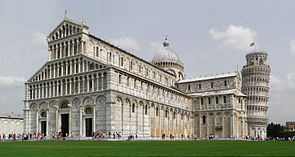 The Leaning Tower of Pisa and the Duomo di Pisa, in the Piazza dei Miracoli. The Piazza is a UNESCO World Heritage Site,[174] and both buildings are examples of Romanesque architecture.[175]
The Leaning Tower of Pisa and the Duomo di Pisa, in the Piazza dei Miracoli. The Piazza is a UNESCO World Heritage Site,[174] and both buildings are examples of Romanesque architecture.[175]
Italy has a very broad and diverse architectural style, which cannot be simply classified by period, but also by region, due to Italy's division into several city-states until 1861. However, this has created a highly diverse and eclectic range in architectural designs. Italy is known for its considerable architectural achievements,[176] such as the construction of arches, domes and similar structures during ancient Rome, the founding of the Renaissance architectural movement in the late-14th to 16th century, and being the homeland of Palladianism, a style of construction which inspired movements such as that of Neoclassical architecture, and influenced the designs which noblemen built their country houses all over the world, notably in the UK, Australia and the US during the late-17th to early 20th centuries. Several of the finest works in Western architecture, such as the Colosseum, the Milan Cathedral and Florence cathedral, the Leaning Tower of Pisa and the building designs of Venice are found in Italy.
Italian architecture has also widely influenced the architecture of the world. Italianate architecture, popular abroad from the 16th to mid-20th century, was used to describe foreign architecture which was built in an Italian style. British architect Inigo Jones, inspired by the avant-garde designs of Italian buildings and cities, in the early-17th century, brought back these ideas with him to London, and ever since, this Italianate architecture has been popular in construction designs all over the world.
Visual art
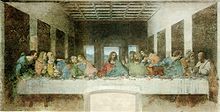 The Last Supper by Leonardo da Vinci: equally to Mona Lisa, it is the most famous, most reproduced and most parodied portrait and religious painting of all time.[177]
The Last Supper by Leonardo da Vinci: equally to Mona Lisa, it is the most famous, most reproduced and most parodied portrait and religious painting of all time.[177]
Over the centuries, Italian art has gone through many stylistic changes. Italian painting is traditionally characterized by a warmth of colour and light, as exemplified in the works of Caravaggio and Titian, and a preoccupation with religious figures and motifs. Italian painting enjoyed preeminence in Europe for hundreds of years, from the Romanesque and Gothic periods, and through the Renaissance and Baroque periods, the latter two of which saw fruition in Italy. Notable artists who fall within these periods include Michelangelo, Leonardo da Vinci, Donatello, Botticelli, Fra Angelico, Tintoretto, Caravaggio, Bernini, Titian and Raphael.
Thereafter, Italy was to experience a continual subjection to foreign powers which caused a shift of focus to political matters, leading to its decline as the artistic authority in Europe. Not until 20th century Futurism, primarily through the works of Umberto Boccioni and Giacomo Balla, would Italy recapture any of its former prestige as a seminal place of artistic evolution. Futurism was succeeded by the metaphysical paintings of Giorgio de Chirico, who exerted a strong influence on the Surrealists and generations of artists to follow.
Literature and theatre
Main article: Literature of Italy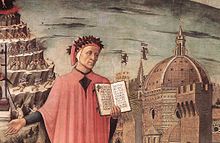 Dante, poised between the mountain of purgatory and the city of Florence, displays the famous incipit Nel mezzo del cammin di nostra vita in a detail of Domenico di Michelino's painting, Florence 1465.
Dante, poised between the mountain of purgatory and the city of Florence, displays the famous incipit Nel mezzo del cammin di nostra vita in a detail of Domenico di Michelino's painting, Florence 1465.
The basis of the modern Italian language was established by the Florentine poet Dante Alighieri, whose greatest work, the Divine Comedy, is considered amongst the foremost literary statements produced in Europe during the Middle Ages. There is no shortage of celebrated literary figures in Italy: Giovanni Boccaccio, Giacomo Leopardi, Alessandro Manzoni, Torquato Tasso, Ludovico Ariosto, and Petrarch, whose best-known vehicle of expression, the sonnet, was invented in Italy.
Prominent philosophers include Giordano Bruno, Marsilio Ficino, Niccolò Machiavelli, and Giambattista Vico. Modern literary figures and Nobel laureates are nationalist poet Giosuè Carducci in 1906, realist writer Grazia Deledda in 1926, modern theatre author Luigi Pirandello in 1936, poets Salvatore Quasimodo in 1959 and Eugenio Montale in 1975, satirist and theatre author Dario Fo in 1997.[178]
Italian theatre can be traced back to the Roman tradition which was heavily influenced by the Greek; as with many other literary genres, Roman dramatists tended to adapt and translate from the Greek. For example, Seneca's Phaedra was based on that of Euripides, and many of the comedies of Plautus were direct translations of works by Menander. During the 16th century and on into the 18th century, Commedia dell'arte was a form of improvisational theatre, and it is still performed today. Travelling troupes of players would set up an outdoor stage and provide amusement in the form of juggling, acrobatics, and, more typically, humorous plays based on a repertoire of established characters with a rough storyline, called canovaccio.
Music
 Giacomo Puccini, Italian composer whose operas, including La bohème, Tosca, Madama Butterfly, and Turandot, are among the most frequently worldwide performed in the standard repertoire.[179][180]
Giacomo Puccini, Italian composer whose operas, including La bohème, Tosca, Madama Butterfly, and Turandot, are among the most frequently worldwide performed in the standard repertoire.[179][180]
From folk music to classical, music has always played an important role in Italian culture. Instruments associated with classical music, including the piano and violin, were invented in Italy, and many of the prevailing classical music forms, such as the symphony, concerto, and sonata, can trace their roots back to innovations of 16th and 17th century Italian music.
Italy's most famous composers include the Renaissance composers Palestrina and Monteverdi, the Baroque composers Alessandro Scarlatti, Corelli and Vivaldi, the Classical composers Paganini and Rossini, and the Romantic composers Verdi and Puccini. Modern Italian composers such as Berio and Nono proved significant in the development of experimental and electronic music. While the classical music tradition still holds strong in Italy, as evidenced by the fame of its innumerable opera houses, such as La Scala of Milan and San Carlo of Naples, and performers such as the pianist Maurizio Pollini and the late tenor Luciano Pavarotti, Italians have been no less appreciative of their thriving contemporary music scene.
Italy is widely known for being the birthplace of opera.[181] Italian opera was believed to have been founded in the early 17th century, in Italian cities such as Mantua and Venice.[181] Later, works and pieces composed by native Italian composers of the 19th century and early 20th century, such as Rossini, Bellini, Donizetti, Verdi and Puccini, are amongst the most famous operas ever written and today are performed in opera houses across the world. La Scala operahouse in Milan is also renowned as one of the best in the world. Famous Italian opera singers include Enrico Caruso, Alessandro Bonci, the late Luciano Pavarotti, and Andrea Bocelli, to name a few.
Introduced in the early 1920s, jazz took a particularly strong foothold in Italy, and remained popular despite the xenophobic cultural policies of the Fascist regime. Today, the most notable centers of jazz music in Italy include Milan, Rome, and Sicily. Later, Italy was at the forefront of the progressive rock movement of the 1970s, with bands like PFM and Goblin. Italy was also an important country in the development of disco and electronic music, with Italo disco, known for its futuristic sound and prominent usage of synthesizers and vocoders, being one of the earliest electronic dance genres,[182] as well as European forms of disco music aside from Euro disco (which later went on to influence several genres such as Eurodance and Nu-disco). Producers/songwriters such as Giorgio Moroder, who won three Academy Awards for his music, were highly influential in the development of EDM (electronic dance music).[182] Today, Italian pop music is represented annually with the Sanremo Music Festival, which served as inspiration for the Eurovision song contest, and the Festival of Two Worlds in Spoleto. Singers such as pop diva Mina, classical crossover artist Andrea Bocelli, Grammy winner Laura Pausini, and European chart-topper Eros Ramazzotti have attained international acclaim.
Cinema
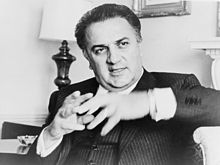 Federico Fellini, considered one of the most influential and widely revered filmmakers of the 20th century.[183]
Federico Fellini, considered one of the most influential and widely revered filmmakers of the 20th century.[183]
The history of Italian cinema began a few months after the Lumière brothers began motion picture exhibitions. The first Italian film was a few seconds long, showing Pope Leo XIII giving a blessing to the camera. The Italian film industry was born between 1903 and 1908 with three companies: the Società Italiana Cines, the Ambrosio Film and the Itala Film. Other companies soon followed in Milan and in Naples. In a short time these first companies reached a fair producing quality, and films were soon sold outside Italy. Cinema was later used by Benito Mussolini, who founded Rome's renowned Cinecittà studio for the production of Fascist propaganda until World War II.[184]
After the war, Italian film was widely recognised and exported until an artistic decline around the 1980s. Notable Italian film directors from this period include Vittorio De Sica, Federico Fellini, Sergio Leone, Pier Paolo Pasolini, Luchino Visconti, Michelangelo Antonioni and Dario Argento. Movies include world cinema treasures such as La dolce vita, Il buono, il brutto, il cattivo and Ladri di biciclette. The mid-1940s to the early 50s was the heyday of neorealist films, reflecting the poor condition of post-war Italy.[185][186] As the country grew wealthier in the 1950s, a form of neorealism known as pink neorealism succeeded, and other film genres, such as sword-and-sandal followed as spaghetti westerns, were popular in the 1960s and 70s. In recent years, the Italian scene has received only occasional international attention, with movies like La vita è bella directed by Roberto Benigni and Il postino with Massimo Troisi.
Science
Main article: Science and technology in ItalyThrough the centuries, Italy has given birth to some notable scientific minds. Amongst them, and perhaps the most famous polymath in history, Leonardo da Vinci made several contributions to a variety of fields including art, biology, and technology. Galileo Galilei was a physicist, mathematician, and astronomer who played a major role in the Scientific Revolution. His achievements include improvements to the telescope and consequent astronomical observations, and support for Copernicanism. The physicist Enrico Fermi, a Nobel prize laureate, was the leader of the team that built the first nuclear reactor and is also noted for his many other contributions to physics, including the co-development of the quantum theory.
A brief overview of some other notable figures includes the astronomer Giovanni Domenico Cassini, who made many important discoveries about the Solar System; the physicist Alessandro Volta, inventor of the electric battery; the mathematicians Lagrange, Fibonacci, and Gerolamo Cardano, whose Ars Magna is generally recognized as the first modern treatment on mathematics, made fundamental advances to the field; Marcello Malpighi, a doctor and founder of microscopic anatomy; the biologist Lazzaro Spallanzani, who conducted important research in bodily functions, animal reproduction, and cellular theory; the physician, pathologist, scientist, and Nobel laureate Camillo Golgi, whose many achievements include the discovery of the Golgi complex, and his role in paving the way to the acceptance of the Neuron doctrine; and Guglielmo Marconi, who received the Nobel Prize in Physics for the invention of radio.
Sport
Italy has a long sporting tradition. In numerous sports, both individual and team, Italy has good representation and many successes. The most popular sport is by far football. Basketball and volleyball are the next most popular/played, with Italy having a rich tradition in both. Italy won the 2006 FIFA World Cup, and is currently the second most successful football team in the world, after Brazil, having won four FIFA World Cups.[190] Italy has also got strong traditions in cycling, tennis, athletics, fencing, winter sports and rugby. Italian Scuderia Ferrari is the oldest surviving team in Grand Prix racing, having competed since 1948, and statistically the most successful Formula One team in history with a record of 15 drivers' championships and 16 constructors' championships.
Fashion and design
Main articles: Italian fashion and Italian designItalian fashion has a long tradition, and is regarded as one of the most important in the world, along with French fashion, American fashion, British fashion and Japanese fashion. Milan, Florence and Rome are Italy's main fashion capitals, however Naples, Turin, Venice, Bologna, Genoa and Vicenza are other major centres. According to the 2009 Global Language Monitor, Milan was nominated the true fashion capital of the world, even surpassing other international cities, such as New York, Paris, London and Tokyo, and Rome came 4th.[191] Major Italian fashion labels, such as Gucci, Prada, Versace, Valentino, Armani, Dolce & Gabbana, Missoni, Fendi, Moschino, Max Mara and Ferragamo, to name a few, are regarded as amongst the finest fashion houses in the world. Also, the fashion magazine Vogue Italia, is considered the most important and prestigious fashion magazine in the world.[192]
Italy is also prominent in the field of design, notably interior design, architectural design, industrial design and urban design. Italy has produced some well-known furniture designers, such as Gio Ponti and Ettore Sottsass, and Italian phrases such as "Bel Disegno" and "Linea Italiana" have entered the vocabulary of furniture design.[193] Examples of classic pieces of Italian white goods and pieces of furniture include Zanussi's washing machines and fridges,[194] the "New Tone" sofas by Atrium,[194] and the post-modern bookcase by Ettore Sottsass, inspired by Bob Dylan's song Memphis Blues.[194] Today, Milan and Turin are the nation's leaders in architectural design and industrial design. The city of Milan hosts the FieraMilano, Europe's biggest design fair.[195] Milan also hosts major design and architecture-related events and venues, such as the "Fuori Salone" and the Salone del Mobile, and has been home to the designers Bruno Munari, Lucio Fontana, Enrico Castellani and Piero Manzoni[196]
Cuisine
Modern Italian cuisine has evolved through centuries of social and political changes, with its roots reaching back to the 4th century BC. Significant change occurred with the discovery of the New World, when vegetables such as potatoes, tomatoes, bell peppers, and maize became available. However, these central ingredients of modern Italian cuisine were not introduced in scale before the 18th century.[197]
Ingredients and dishes vary by region. However, many dishes that were once regional have proliferated in different variations across the country. Cheese and wine are major parts of the cuisine, playing different roles both regionally and nationally with their many variations and Denominazione di origine controllata (regulated appellation) laws. Coffee, and more specifically espresso, has become highly important to the cultural cuisine of Italy. Some famous dishes and items include pasta, pizza, lasagna, focaccia, and gelato.
See also
- Outline of Italy
- Index of Italy-related articles
- List of English exonyms for Italian toponyms
Notes
- ^ In Italy, other languages have been officially recognised as legitimate autochthonous (regional) languages under the European Charter for Regional or Minority Languages. In each of these, Italy's official name is as follows:
- ^ Official French maps show the border detouring south of the main summit, and claim the highest point in Italy is Mont Blanc de Courmayeur (4,748 m), but these are inconsistent with an 1861 convention and topographic watershed analysis.
- ^ Regions in Italics have an autonomous status.
- ^ According to Mitrica, an October 2005 Romanian report estimates that 1,061,400 Romanians are living in Italy, constituting 37% of 2.8 million immigrants in that country[130] but it is unclear how the estimate was made, and therefore whether it should be taken seriously.
References
- ^ "Ethnologue report". Ethnologue.com. http://www.ethnologue.com/show_country.asp?name=IT. Retrieved 30 October 2010.
- ^ "Monthly demographic balance: January 2011" (in Italian). Istat. 10 September 2011. http://demo.istat.it/bilmens2011gen/index.html. Retrieved 10 September 2011.
- ^ a b c d "Italy". International Monetary Fund. http://www.imf.org/external/pubs/ft/weo/2011/02/weodata/weorept.aspx?sy=2009&ey=2016&scsm=1&ssd=1&sort=country&ds=.&br=1&c=136&s=NGDPD%2CNGDPDPC%2CPPPGDP%2CPPPPC%2CLP&grp=0&a=&pr1.x=27&pr1.y=19. Retrieved 14 October 2011.
- ^ "Distribution of family income – Gini index". CIA – The World Factbook. https://www.cia.gov/library/publications/the-world-factbook/fields/2172.html. Retrieved 9 July 2010.
- ^ "Human Development Report 2011". United Nations. 2011. http://hdr.undp.org/en/media/HDR_2011_EN_Table1.pdf. Retrieved 5 November 2011.
- ^ "Comune di Campione d'Italia". Comune.campione-d-italia.co.it. 14 July 2010. http://www.comune.campione-d-italia.co.it/. Retrieved 30 October 2010.
- ^ "Italy: Birthplace of the Renaisssance". European Renaissance and Reformation. Township of Washington, NJ: Immaculate Heart Academy. [n.d.]. http://www.immaculateheartacademy.org/outside2/socialstudies/kuhns/1%20Italy%20Birthplace%20of%20the%20Renaissance.pdf. Retrieved 20 December 2009.[unreliable source?]
- ^ "Unification of Italy". Library.thinkquest.org. 4 April 2003. http://library.thinkquest.org/TQ0312582/unification.html. Retrieved 19 November 2009.
- ^ "The Italian Colonial Empire". All Empires. http://www.allempires.com/article/index.php?q=italian_colonial. Retrieved 30 October 2010.
- ^ Human Development Report 2010[dead link]. The United Nations. Retrieved 5 October 2009.
- ^ a b The Economist Intelligence Unit’s quality-of-life index, Economist, 2005
- ^ "Report for Selected Countries and Subjects". Imf.org. 14 September 2006. http://imf.org/external/pubs/ft/weo/2009/02/weodata/weorept.aspx?pr.x=26&pr.y=9&sy=2009&ey=2009&scsm=1&ssd=1&sort=country&ds=.&br=1&c=512%2C941%2C914%2C446%2C612%2C666%2C614%2C668%2C311%2C672%2C213%2C946%2C911%2C137%2C193%2C962%2C122%2C674%2C912%2C676%2C313%2C548%2C419%2C556%2C513%2C678%2C316%2C181%2C913%2C682%2C124%2C684%2C339%2C273%2C638%2C921%2C514%2C948%2C218%2C943%2C963%2C686%2C616%2C688%2C223%2C518%2C516%2C728%2C918%2C558%2C748%2C138%2C618%2C196%2C522%2C278%2C622%2C692%2C156%2C694%2C624%2C142%2C626%2C449%2C628%2C564%2C228%2C283%2C924%2C853%2C233%2C288%2C632%2C293%2C636%2C566%2C634%2C964%2C238%2C182%2C662%2C453%2C960%2C968%2C423%2C922%2C935%2C714%2C128%2C862%2C611%2C716%2C321%2C456%2C243%2C722%2C248%2C942%2C469%2C718%2C253%2C724%2C642%2C576%2C643%2C936%2C939%2C961%2C644%2C813%2C819%2C199%2C172%2C184%2C132%2C524%2C646%2C361%2C648%2C362%2C915%2C364%2C134%2C732%2C652%2C366%2C174%2C734%2C328%2C144%2C258%2C146%2C656%2C463%2C654%2C528%2C336%2C923%2C263%2C738%2C268%2C578%2C532%2C537%2C944%2C742%2C176%2C866%2C534%2C369%2C536%2C744%2C429%2C186%2C433%2C925%2C178%2C746%2C436%2C926%2C136%2C466%2C343%2C112%2C158%2C111%2C439%2C298%2C916%2C927%2C664%2C846%2C826%2C299%2C542%2C582%2C443%2C474%2C917%2C754%2C544%2C698&s=NGDPDPC&grp=0&a=. Retrieved 2 August 2010.
- ^ "DDP Quick Query". Ddp-ext.worldbank.org. 20 July 2004. http://ddp-ext.worldbank.org/ext/DDPQQ/member.do?method=getMembers&userid=1&queryId=135. Retrieved 2 August 2010.
- ^ "Report for Selected Countries and Subjects". Imf.org. 14 September 2006. http://www.imf.org/external/pubs/ft/weo/2009/01/weodata/weorept.aspx?sy=2008&ey=2008&scsm=1&ssd=1&sort=country&ds=.&br=1&c=512%2C941%2C914%2C446%2C612%2C666%2C614%2C668%2C311%2C672%2C213%2C946%2C911%2C137%2C193%2C962%2C122%2C674%2C912%2C676%2C313%2C548%2C419%2C556%2C513%2C678%2C316%2C181%2C913%2C682%2C124%2C684%2C339%2C273%2C638%2C921%2C514%2C948%2C218%2C943%2C963%2C686%2C616%2C688%2C223%2C518%2C516%2C728%2C918%2C558%2C748%2C138%2C618%2C196%2C522%2C278%2C622%2C692%2C156%2C694%2C624%2C142%2C626%2C449%2C628%2C564%2C228%2C283%2C924%2C853%2C233%2C288%2C632%2C293%2C636%2C566%2C634%2C964%2C238%2C182%2C662%2C453%2C960%2C968%2C423%2C922%2C935%2C714%2C128%2C862%2C611%2C716%2C321%2C456%2C243%2C722%2C248%2C942%2C469%2C718%2C253%2C724%2C642%2C576%2C643%2C936%2C939%2C961%2C644%2C813%2C819%2C199%2C172%2C184%2C132%2C524%2C646%2C361%2C648%2C362%2C915%2C364%2C134%2C732%2C652%2C366%2C174%2C734%2C328%2C144%2C258%2C146%2C656%2C463%2C654%2C528%2C336%2C923%2C263%2C738%2C268%2C578%2C532%2C537%2C944%2C742%2C176%2C866%2C534%2C369%2C536%2C744%2C429%2C186%2C433%2C925%2C178%2C746%2C436%2C926%2C136%2C466%2C343%2C112%2C158%2C111%2C439%2C298%2C916%2C927%2C664%2C846%2C826%2C299%2C542%2C582%2C443%2C474%2C917%2C754%2C544%2C698&s=PPPGDP&grp=0&a=&pr.x=9&pr.y=12. Retrieved 2 August 2010.
- ^ "CIA World Factbook, Budget". Cia.gov. https://www.cia.gov/library/publications/the-world-factbook/fields/2056.html. Retrieved 26 January 2011.
- ^ M. De Leonardis, Il Mediterraneo nella politica estera italiana del secondo dopoguerra, Bologna, Il Mulino, 2003, p. 17
- ^ The Middle East and Europe. Google Books. 1998-11-24. http://books.google.com/?id=X4xw8-Oj9usC&pg=PA157&lpg=PA157&dq=regional+power+italy+in+europe#PPP1,M1. Retrieved 2011-05-30.
- ^ "KOF – Pressemitteilung" (PDF). http://globalization.kof.ethz.ch/static/pdf/press_release_2009_en.pdf. Retrieved 27 October 2009.
- ^ Alberto Manco, Italia. Disegno storico-linguistico, 2009, Napoli, L'Orientale, ISBN 978-88-95044-62-0
- ^ OLD, p. 974: "first syll. naturally short (cf. Quint.Inst.1.5.18), and so scanned in Lucil.825, but in dactylic verse lengthened metri gratia."
- ^ J.P. Mallory and D.Q. Adams, Encyclopedia of Indo-European Culture (London: Fitzroy and Dearborn, 1997), 24.
- ^ Dionysius of Halicarnassus, Roman Antiquities, 1.35, on LacusCurtius
- ^ Aristotle, Politics, 7.1329b, on Perseus
- ^ Thucydides, The Peloponnesian War, 6.2.4, on Perseus
- ^ Pallottino, M., History of Earliest Italy, trans. Ryle, M & Soper, K. in Jerome Lectures, Seventeenth Series, p. 50
- ^ Kluwer Academic/Plenum Publishers 2001, ch. 2. ISBN 0-306-46463-2.
- ^ The Mycenaeans and Italy: the archaeological and archaeometric ceramic evidence, University of Glasgow, Department of Archaeology
- ^ Emilio Peruzzi, Mycenaeans in early Latium, (Incunabula Graeca 75), Edizioni dell'Ateneo & Bizzarri, Roma, 1980
- ^ Lord William Taylour, Mycenaean Pottery in Italy and Adjacent Areas (Cambridge 1958)
- ^ Gert Jan van Wijngaarden, Use and Appreciation of Mycenaean Pottery in the Levant, Cyprus and Italy (1600-1200 B.C.): The Significance of Context, Amsterdam Archaeological Studies, Amsterdam University Press, 2001
- ^ Andrea Vianello, Late Bronze Age Mycenaean and Italic Products in the West Mediterranean: A Social and Economic Analysis, (British Archaeological Reports International Series), British Archaeological Reports
- ^ Miriam S. Balmuth, Robert J. Rowland, Studies in Sardinian archaeology, University of Michigan Press, 1984
- ^ Bryan Feuer, Mycenaean civilization: an annotated bibliography through 2002, McFarland & Company; Rev Sub edition (2 March 2004)
- ^ Stéphane Barry and Norbert Gualde, "The Biggest Epidemics of History" (La plus grande épidémie de l'histoire), in L'Histoire n° 310, June 2006, pp. 45–46
- ^ "Plague[dead link]". Brown University.
- ^ Jensen 1992, p. 64.
- ^ Karl Julius Beloch, Bevölkerungsgeschichte Italiens, volume 3, pp. 359–360.
- ^ Thomas James Dandelet, John A. Marino (2007). Spain in Italy: politics, society, and religion 1500-1700. Leiden: Koninklijke Brill. ISBN 978-90-04-15429-2.
- ^ Napoleon Bonaparte, "The Economy of the Empire in Italy: Instructions from Napoleon to Eugène, Viceroy of Italy," Exploring the European Past: Texts & Images, Second Edition, ed. Timothy E. Gregory (Mason: Thomson, 2007), 65-66.
- ^ (Mack Smith, Denis (1997). Modern Italy; A Political History. Ann Arbor: The University of Michigan Press. ISBN 0-472-10895-6
- ^ (Bosworth (2005), pp. 49.)
- ^ Mortara, G (1925). La Salute pubblica in Italia durante e dopo la Guerra. New Haven: Yale University Press.
- ^ "Italy – Britannica Online Encyclopedia". Britannica.com. http://www.britannica.com/EBchecked/topic/297474/Italy#. Retrieved 2 August 2010.
- ^ Adrian Lyttelton (editor), "Liberal and fascist Italy, 1900–1945", Oxford University Press, 2002. pp. 13
- ^ "Italia 1946: le donne al voto, dossier a cura di Mariachiara Fugazza e Silvia Cassamagnaghi" (PDF). http://www.insmli.it/pubblicazioni/35/Voto%20donne%20versione%20def.pdf. Retrieved 2011-05-30.
- ^ (Italian) "Commissione parlamentare d'inchiesta sul terrorismo in Italia e sulle cause della mancata individuazione dei responsabili delle stragi (Parliamentary investigative commission on terrorism in Italy and the failure to identify the perpetrators)". 1995. Archived from the original on 2006-08-19. http://web.archive.org/web/20060819211212/http://www.isn.ethz.ch/php/documents/collection_gladio/report_ital_senate.pdf. Retrieved 2006-05-02.
- ^ (English)/(Italian)/(French)/(German) "Secret Warfare: Operation Gladio and NATO's Stay-Behind Armies". Swiss Federal Institute of Technology / International Relation and Security Network. Archived from the original on 2006-04-25. http://web.archive.org/web/20060425182721/http://www.isn.ethz.ch/php/collections/coll_gladio.htm#Documents. Retrieved 2006-05-02.
- ^ "Clarion: Philip Willan, Guardian, 24 June 2000, page 19". Cambridgeclarion.org. 2000-06-24. http://www.cambridgeclarion.org/press_cuttings/us.terrorism_graun_24jun2000.html. Retrieved 2010-04-24.
- ^ "Morphometric and hydrological characteristics of some important Italian lakes". Largo Tonolli 50, 28922 Verbania Pallanza: Istituto per lo Studio degli Ecosistemi. http://www.iii.to.cnr.it/limnol/cicloac/lagit.htm. Retrieved 3 March 2010.
- ^ "Italy – Environment". Dev.prenhall.com. http://dev.prenhall.com/divisions/hss/worldreference/IT/environment.html. Retrieved 2 August 2010.
- ^ "National Parks in Italy". Parks.it. 1995-2010. http://www.parks.it/indice/NatParks.html. Retrieved 15 March 2010.
- ^ REN21 (15 July 2010). "Renewables 2010 Global Status Report". REN21. http://www.ren21.net/Portals/97/documents/GSR/REN21_GSR2011.pdf. Retrieved 16 July 2010.
- ^ "Photovoltaic energy barometer 2010 – EurObserv’ER". http://www.eurobserv-er.org/pdf/baro196.asp. Retrieved 30 October 2010.
- ^ "World Wind Energy Report 2010" (PDF). Report. World Wind Energy Association. February 2011. http://www.wwindea.org/home/images/stories/pdfs/worldwindenergyreport2010_s.pdf. Retrieved 8-August-2011.
- ^ wwea
- ^ "Italy – Environment". Encyclopedia of the Nations. http://www.nationsencyclopedia.com/Europe/Italy-ENVIRONMENT.html. Retrieved 7 April 2010.
- ^ United Nations Statistics Division, Millennium Development Goals indicators: Carbon dioxide emissions (CO2), thousand metric tons of CO2 (collected by CDIAC)
- ^ Human-produced, direct emissions of carbon dioxide only. Excludes other greenhouse gases; land-use, land-use-change and forestry (LULUCF); and natural background flows of CO2 (See also: Carbon cycle)
- ^ [1][dead link]
- ^ Italy nuclear: Berlusconi accepts referendum blow, BBC News Europe, 14 June 2011
- ^ Nick Squires (2 October 2009). "Sicily mudslide leaves scores dead". London: The Daily Telegraph. http://www.telegraph.co.uk/news/worldnews/europe/italy/6255575/Sicily-mudslide-leaves-scores-dead.html#. Retrieved 2 October 2009.
- ^ Thomas A. Blair, Climatology: General and Regional, Prentice Hall pages 131–132; Adriana Rigutti, Meteorologia, Giunti, p, 95, 2009.
- ^ Smyth, Howard McGaw Italy: From Fascism to the Republic (1943–1946) The Western Political Quarterly vol. 1 no. 3 (pp. 205–222), September 1948
- ^ Claudio Tucci (11 November 2008). "Confesercenti, la crisi economica rende ancor più pericolosa la mafia" (in Italian). Confesercenti. Ilsole24ore.com. http://www.ilsole24ore.com/art/SoleOnLine4/Economia%20e%20Lavoro/2008/11/confesercenti-mafia-racket-pizzo.shtml?uuid=20ff3b9c-afe7-11dd-8057-9c09c8bfa449. Retrieved 21 April 2011.
- ^ Nick Squires (09 Jan 2010). "Italy claims finally defeating the mafia". Telegraph.co.uk. http://www.telegraph.co.uk/news/worldnews/europe/italy/6957240/Italy-claims-finally-defeating-the-mafia.html. Retrieved 21 April 2011.
- ^ Kiefer, Peter (October 22, 2007). "Mafia crime is 7% of GDP in Italy, group reports". The New York Times. http://www.nytimes.com/2007/10/22/world/europe/22iht-italy.4.8001812.html?_r=1. Retrieved April 19, 2011.
- ^ Maria Loi (October 1, 2009). "Rapporto Censis: 13 milioni di italiani convivono con la mafia" (in Italian). Censis. Antimafia Duemila. http://www.antimafiaduemila.com/content/view/20052/78/. Retrieved April 21, 2011.
- ^ Kington, Tom (1 October 2009). "Mafia's influence hovers over 13m Italians, says report". The Guardian (London). http://www.guardian.co.uk/world/2009/oct/01/mafia-influence-hovers-over-italians. Retrieved 5 May 2010.
- ^ ANSA (March 14, 2011). "Italy: Anti-mafia police arrest 35 suspects in northern Lombardy region". adnkronos.com. Mafia Today. http://mafiatoday.com/sicilian-mafia-ndrangheta/italy-anti-mafia-police-arrest-35-suspects-in-northern-lombardy-region/. Retrieved April 21, 2011.
- ^ "Crime Statistics > Murders (per capita) (most recent) by country". NationMaster.com. http://www.nationmaster.com/graph/cri_mur_percap-crime-murders-per-capita. Retrieved 4 April 2010.
- ^ "Italian soldiers leave for Lebanon Corriere della Sera, 30 August 2006
- ^ "Law n°6433 of September, 3 1999". Difesa.it. http://www.difesa.it/Difesa-cittadino/Riforma+del+Servizio+Militare.htm. Retrieved 30 October 2010.[dead link]
- ^ "The Military Balance 2010", pp. 141–145. International Institute for Strategic Studies, 3 February 2010.
- ^ Italian Ministry of Defence. "Nota aggiuntiva allo stato di previsione per la Difesa per l'anno 2009" (in Italian). http://www.difesa.it/NR/rdonlyres/5EF11493-59DD-4FB7-8485-F4258D9F5891/0/Nota_Aggiuntiva_2009.pdf. Retrieved 27 April 2009.[dead link]
- ^ Hans M. Kristensen / Natural Resources Defense Council (2005). "NRDC: U.S. Nuclear Weapons in Europe – part 1" (PDF). http://www.nrdc.org/nuclear/euro/euro_pt1.pdf. Retrieved 2011-05-30.
- ^ "Marina Militare (Italian military navy website)" (in Italian). Marina.difesa.it. http://www.marina.difesa.it/. Retrieved 2011-05-30.
- ^ "The Carabinieri Force is linked to the Ministry of Defence". Carabinieri. http://www.carabinieri.it/Internet/Multilingua/EN/GoverningBodies/. Retrieved 14 May 2010.
- ^ http://siteresources.worldbank.org/DATASTATISTICS/Resources/GDP.pdf
- ^ http://siteresources.worldbank.org/DATASTATISTICS/Resources/GDP_PPP.pdf
- ^ "Hobsons Careers in Europe | Country profiles". Careersineurope.hobsons.com. http://www.careersineurope.hobsons.com/country_italy.aspx. Retrieved 2 August 2010.
- ^ "GDP per capita in PPS". Eurostat. http://epp.eurostat.ec.europa.eu/cache/ITY_PUBLIC/2-25062009-BP/EN/2-25062009-BP-EN.PDF. Retrieved 25 June 2009.
- ^ [2] Ocse, tasso di disoccupazione stabile nell'eurozona
- ^ a b c d "Italy – Economics". Dev.prenhall.com. http://dev.prenhall.com/divisions/hss/worldreference/IT/economics.html. Retrieved 2 August 2010.
- ^ Pisa, Nick (12 June 2011). "Italy overtakes France to become world's largest wine producer". The Telegraph. http://www.telegraph.co.uk/foodanddrink/wine/8571222/Italy-overtakes-France-to-become-worlds-largest-wine-producer.html. Retrieved 17 August 2011.
- ^ "Knowledge Economy Forum 2008: Innovative Small And Medium Enterprises Are Key To Europe & Central Asian Growth". The World Bank. 19 May 2005. http://web.worldbank.org/WBSITE/EXTERNAL/COUNTRIES/ECAEXT/0,,contentMDK:21808326~menuPK:258604~pagePK:2865106~piPK:2865128~theSitePK:258599,00.html. Retrieved 17 June 2008.
- ^ "2010 Press Releases – Trade to expand by 9.5% in 2010 after a dismal 2009, WTO reports – Press/598". WTO. http://www.wto.org/english/news_e/pres10_e/pr598_e.htm. Retrieved 2011-05-30.
- ^ "CIA – The World Factbook". CIA. https://www.cia.gov/library/publications/the-world-factbook/geos/it.html. Retrieved 26 January 2011.
- ^ http://mkt.unwto.org/sites/all/files/docpdf/unwtohighlights11enhr_1.pdf
- ^ Nicholas Crafts, Gianni Toniolo (1996). Economic growth in Europe since 1945. Cambridge University Press. p. 428. ISBN 0-521-49627-6.
- ^ Eurostat. "Real GDP growth rate – Growth rate of GDP volume – percentage change on previous year". http://epp.eurostat.ec.europa.eu/tgm/table.do?tab=table&init=1&plugin=1&language=en&pcode=tsieb020. Retrieved 10 May 2009.
- ^ "Europolitics". Europolitics.info. http://www.europolitics.info/economy-monetary-affairs/deficits-increase-in-eurozone-and-eu-artb287086-50.html. Retrieved 26 January 2011.
- ^ "Could Italy Be Better Off than its Peers?". CNBC. 2010-05-18. http://www.cnbc.com/id/37207942/Could_Italy_Be_Better_Off_than_its_Peers. Retrieved 2011-05-30.
- ^ "EUROPA – Press Releases – Regional GDP per inhabitant in the EU27, GDP per inhabitant in 2006 ranged from 25% of the EU27 average in Nord-Est in Romania to 336% in Inner London". Europa. 19 February 2009. http://europa.eu/rapid/pressReleasesAction.do?reference=STAT/09/23&format=HTML&aged=0&language=EN&guiLanguage=en. Retrieved 30 October 2010.
- ^ "The real sick man of Europe". The Economist. 19 May 2005. http://www.economist.com/opinion/displaystory.cfm?story_id=3987219. Retrieved 10 May 2009.
- ^ "Italy: The sick man of Europe". London: The Daily Telegraph. 29 December 2008. http://www.telegraph.co.uk/comment/3557277/Italy-The-sick-man-of-Europe.html. Retrieved 10 May 2009.
- ^ Eurostat. "Energy, transport and environment indicators". http://epp.eurostat.ec.europa.eu/cache/ITY_OFFPUB/KS-DK-08-001/EN/KS-DK-08-001-EN.PDF. Retrieved 10 May 2009.
- ^ Eurostat. "Panorama of energy". http://epp.eurostat.ec.europa.eu/cache/ITY_OFFPUB/KS-GH-09-001/EN/KS-GH-09-001-EN.PDF. Retrieved 10 May 2009.
- ^ "European Cohesion Policy in Italy" (PDF). http://ec.europa.eu/regional_policy/sources/docgener/informat/country2009/it_en.pdf. Retrieved 30 October 2010.
- ^ "Index of Economic Freedom". The Heritage Foundation. Archived from the original on 3 May 2008. http://web.archive.org/web/20080503060552/http://www.heritage.org/research/features/index/country.cfm?ID=Italy. Retrieved 4 November 2008.
- ^ Eurostat. "R&D Expenditure and Personnel". http://epp.eurostat.ec.europa.eu/cache/ITY_OFFPUB/KS-SF-08-091/EN/KS-SF-08-091-EN.PDF. Retrieved 10 May 2009.
- ^ "Nuovo record di velocità sulla linea AV Milano-Bologna" (in Italian). FSNews. 3 March 2008. Archived from the original on 22 August 2008. http://209.85.129.132/search?q=cache:m5-u7afI-asJ:www.fsnews.it/fsnews/v/index.jsp%3Fvgnextoid%3D07a4a4b1fb478110VgnVCM1000001c42fe0aRCRD. Retrieved 31 December 2008.
- ^ "Record italiano di velocità" (in Italian). Tutto Treno. April 2008. http://www.duegieditrice.it/tuttotreno/default.asp?num=218. Retrieved 2 January 2009.[dead link]
- ^ "200 giorni al primo treno Alta Velocità sulla Milano-Bologna" (in Italian). FSNews. 28 May 2008. http://www.fsnews.it/cms/v/index.jsp?vgnextoid=d203c7bd6d20b110VgnVCM1000003f16f90aRCRD. Retrieved 31 December 2008.
- ^ a b European Commission. "Panorama of Transport" (PDF). http://epp.eurostat.ec.europa.eu/cache/ITY_OFFPUB/KS-DA-07-001/EN/KS-DA-07-001-EN.PDF. Retrieved 3 May 2009.
- ^ EUROSTAT. "Ageing characterises the demographic perspectives of the European societies – Issue number 72/2008". http://epp.eurostat.ec.europa.eu/cache/ITY_OFFPUB/KS-SF-08-072/EN/KS-SF-08-072-EN.PDF. Retrieved 28 April 2009.
- ^ ISTAT. "Crude birth rates, mortality rates and marriage rates 2005–2008" (in Italian). http://demo.istat.it/altridati/indicatori/2008/Tab_1.pdf. Retrieved 10 May 2009.
- ^ ISTAT. "Average number of children born per woman 2005–2008" (in Italian). http://demo.istat.it/altridati/indicatori/2008/Tab_4.pdf. Retrieved 3 May 2009.
- ^ CIA World Factbook 2010
- ^ OECD. "Competitive Cities in the Global Economy" (PDF). http://213.253.134.43/oecd/pdfs/browseit/0406041E.PDF. Retrieved 30 April 2009.[dead link]
- ^ "Causes of the Italian mass emigration". ThinkQuest Library. 15 August 1999. http://library.thinkquest.org/26786/en/articles/view.php3?arKey=4&paKey=7&loKey=0&evKey=&toKey=&torKey=&tolKey=. Retrieved 30 October 2010.
- ^ "Essay on Italian emigration to Eritrea (in Italian)" (PDF). http://www.ilcornodafrica.it/rds-01emigrazione.pdf. Retrieved 30 October 2010.
- ^ Libya – Italian colonization. Britannica Online Encyclopedia.
- ^ Libya cuts ties to mark Italy era.. BBC News. 27 October 2005.
- ^ Election Opens Old Wounds In Trieste. The New York Times. 6 June 1987.
- ^ Consulta Nazionale Emigrazione. Progetto ITENETs – “Gli italiani in Brasile”; pp. 11, 19 . Retrieved 10 September 2008.
- ^ (Spanish) Lee, Adam (3 April 2006). "Unos 20 millones de personas que viven en la Argentina tienen algún grado de descendencia italiana" (in Spanish). http://www.asteriscos.tv/dossier-3.html. Retrieved 27 June 2008.
- ^ American FactFinder, United States Census Bureau. "U.S Census Bureau – Selected Population Profile in the United States". American FactFinder, United States Census Bureau. http://factfinder.census.gov/servlet/IPTable?_bm=y&-reg=ACS_2006_EST_G00_S0201:543;ACS_2006_EST_G00_S0201PR:543;ACS_2006_EST_G00_S0201T:543;ACS_2006_EST_G00_S0201TPR:543&-qr_name=ACS_2006_EST_G00_S0201&-qr_name=ACS_2006_EST_G00_S0201PR&-qr_name=ACS_2006_EST_G00_S0201T&-qr_name=ACS_2006_EST_G00_S0201TPR&-ds_name=ACS_2006_EST_G00_&-TABLE_NAMEX=&-ci_type=A&-redoLog=true&-charIterations=047&-geo_id=01000US&-geo_id=NBSP&-format=&-_lang=en. Retrieved 2011-05-30.
- ^ "The Cambridge survey of world migration". Robin Cohen (1995). Cambridge University Press. p. 143. ISBN 0-521-44405-5
- ^ "Ethnic origins, 2006 counts, for Uruguay, provinces and territories – 20% sample data". http://www.hotelsclick.com/hoteles/UY/Uruguay-DEMOGRAF%C3%ADA-5.html.
- ^ "Ethnic origins, 2006 counts, for Canada, provinces and territories – 20% sample data". http://www12.statcan.ca/english/census06/data/highlights/ethnic/pages/Page.cfm?Lang=E&Geo=PR&Code=01&Data=Count&Table=2&StartRec=1&Sort=3&Display=All&CSDFilter=5000.
- ^ Santander Laya-Garrido, Alfonso. Los Italianos forjadores de la nacionalidad y del desarrollo economico en Venezuela. Editorial Vadell. Valencia, 1978
- ^ "20680-Ancestry by Country of Birth of Parents – Time Series Statistics (2001, 2006 Census Years) – Australia". Australian Bureau of Statistics. 27 June 2007. http://www.censusdata.abs.gov.au/ABSNavigation/prenav/ViewData?action=404&documentproductno=0&documenttype=Details&order=1&tabname=Details&areacode=0&issue=2006&producttype=Census%20Tables&javascript=true&textversion=false&navmapdisplayed=true&breadcrumb=LPTD&&collection=Census&period=2006&productlabel=Ancestry%20by%20Country%20of%20Birth%20of%20Parents%20-%20Time%20Series%20Statistics%20(2001,%202006%20Census%20Years)&producttype=Census%20Tables&method=Place%20of%20Usual%20Residence&topic=Ancestry&. Retrieved 30 December 2008.
- ^ [3][dead link]
- ^ "Italy wakes up to the realities of immigration". The Guardian. 21 February 2010.
- ^ "La popolazione straniera residente in Italia al 1° gennaio 2009 [The Foreign Population Resident in Italy on 1 January 2009]" (in Italian) (PDF). Istat. 8 October 2009. pp. 1–3. http://www.istat.it/salastampa/comunicati/non_calendario/20091008_00/testointegrale20091008.pdf. Retrieved 27 October 2009.
- ^ Elisabeth Rosenthal, "Italy cracks down on illegal immigration". The Boston Globe. 16 May 2008.
- ^ "Milan police in Chinatown clash". BBC News. 13 April 2007.
- ^ "EUROPE: Home to Roma, And No Place for Them". IPS ipsnews.net.
- ^ "Balkan Investigative Reporting Network". Birn.eu.com. 08 11 2007. http://www.birn.eu.com/en/111/15/5745/. Retrieved 4 November 2008.
- ^ Mitrica, Mihai Un milion de romani s-au mutat in Italia ("One million Romanians have moved to Italy"). Evenimentul Zilei, 31 October 2005. Visited 11 April 2006.
- ^ 6.5% of the EU population are foreigners and 9.4% are born abroad, Eurostat, Katya VASILEVA, 34/2011.
- ^ Ethnologue report for language code:ita (Italy) – Gordon, Raymond G., Jr. (ed.), 2005. Ethnologue: Languages of the World, Fifteenth edition. Dallas, Tex.: SIL International. Online version
- ^ Italian Language: Geographic Distribution Discovery Media. Retrieved 16 May 2010.
- ^ "Italian language – Britannica Online Encyclopedia". Britannica.com. 3 November 2008. http://www.britannica.com/EBchecked/topic/297241/Italian-language. Retrieved 19 November 2009.
- ^ [L.cost. 26 febbraio 1948, n. 4, Statuto speciale per la Valle d'Aosta; L.cost. 26 febbraio 1948, n. 5, Statuto speciale per il Trentino-Alto Adige; L.cost. 31 gennaio 1963, n. 1, Statuto speciale della Regione Friuli Venezia Giulia]
- ^ Religious Populations Office for National Statistics
- ^ "Italy: 88% of Italians declare themselves Catholic" (in Italian). Corriere della Sera. 18 January 2006. http://www.corriere.it/Primo_Piano/Cronache/2006/01_Gennaio/17/cattolici.shtml. Retrieved 10 May 2009.
- ^ "ReportDGResearchSocialValuesEN2.PDF" (PDF). http://ec.europa.eu/public_opinion/archives/ebs/ebs_225_report_en.pdf. Retrieved 30 October 2010.
- ^ "Country profile: Vatican". BBC News. 26 October 2009. http://news.bbc.co.uk/1/hi/world/europe/country_profiles/1066140.stm. Retrieved 5 May 2010.
- ^ "The Duomo of Florence | Tripleman". www.tripleman.com. http://www.tripleman.com/index.php?showimage=737. Retrieved 25 March 2010.
- ^ "Brunelleschi's Dome". Brunelleschi's Dome.com. http://www.brunelleschisdome.com/. Retrieved 25 March 2010.
- ^ "The Cardinals of the Holy Roman Church – Living cardinals arranged by country". Fiu.edu. 15 October 2010. http://www.fiu.edu/~mirandas/countrynow.htm#Top. Retrieved 30 October 2010.
- ^ "Italy – Italian Language, Culture, Customs and Business Etiquette". Kwintessential. http://www.kwintessential.co.uk/resources/global-etiquette/italy-country-profile.html. Retrieved 2 August 2010.
- ^ "The Holy Orthodox Archdiocese of Italy and Malta". Ortodossia – Arcidiocesi Ortodossa d'Italia e Malta. http://www.ortodossia.it/The%20Holy%20Orthodox%20Archdiocese%20of%20Italy%20ed%20Malta.htm. Retrieved 30 October 2010.
- ^ "Le religioni in Italia: I Testimoni di Geova (Religions in Italy: The Jehovah's Witnesses)" (in Italian). Center for Studies on New Religions. http://www.cesnur.org/religioni_italia/t/testimoni_geova_02.htm. Retrieved 2011-05-30.
- ^ "Chiesa Evangelica Valdese – Unione delle chiese Metodiste e Valdesi (Waldensian Evangelical Church – Union of Waldensian and Methodist churches)" (in Italian). Chiesa Evangelica Valdese – Unione delle chiese Metodiste e Valdesi (Waldensian Evangelical Church – Union of Waldensian and Methodist churches. http://www.chiesavaldese.org/pages/storia/dove_viviamo.php. Retrieved 2011-05-30.
- ^ "World Council of Churches – Evangelical Methodist Church in Italy". World Council of Churches. http://www.oikoumene.org/en/member-churches/regions/europe/italy/evangelical-methodist-church-in-italy.html. Retrieved 30 October 2010.
- ^ "Italy: Country's muslims raise funds to help quake victims – Adnkronos Religion". Adnkronos. 7 April 2003. http://www.adnkronos.com/AKI/English/Religion/?id=3.0.3202304679. Retrieved 30 October 2010.
- ^ "Muslims in Europe: Country guide". BBC News. 23 December 2005. http://news.bbc.co.uk/2/hi/europe/4385768.stm. Retrieved 5 May 2010.
- ^ Rosenthal, Elisabeth (25 July 2005). "Pressure is growingon Muslims in Italy". The New York Times. http://www.nytimes.com/2005/07/24/world/europe/24iht-rome.html?_r=1. Retrieved 31 March 2010.
- ^ "NRI Sikhs in Italy". Nriinternet.com. 15 November 2004. http://www.nriinternet.com/EUROPE/ITALY/2004/111604Gurdwara.htm. Retrieved 30 October 2010.
- ^ "Unione Buddhista Italiana – UBI: L'Ente". Buddhismo.it. 18 August 2009. http://www.buddhismo.it/ente.htm. Retrieved 30 October 2010.
- ^ "Most Baha'i Nations (2005)". QuickLists > Compare Nations > Religions >. The Association of Religion Data Archives. 2005. http://www.thearda.com/QuickLists/QuickList_40c.asp. Retrieved 30 January 2010.
- ^ "Il Tempo – È il più grande ateneo d'Europa". Iltempo.ilsole24ore.com. http://iltempo.ilsole24ore.com/2008/09/20/929140-grande_ateneo_europa.shtml. Retrieved 30 October 2010.
- ^ "Si abbassa l'obbligo scolastico a 15 anni. L'apprendistato diventa scuola". Flcgil.it. http://www.flcgil.it/notizie/news/2010/marzo/si_abbassa_l_obbligo_scolastico_a_15_anni_l_apprendistato_diventa_scuola. Retrieved 30 October 2010.
- ^ Nancy Imelda Schafer, ISI. "SCI-BYTES: Science in Italy, 1998–2002". In-cites.com. http://in-cites.com/research/2003/june_9_2003-1.html. Retrieved 27 January 2010.
- ^ "Conferenze, ospiti, news ed eventi legati agli MBA della SDA Bocconi – MBA SDA Bocconi". SDA Bocconi. http://mba.sdabocconi.it/home/main.php?id=12001&ym=2007-09. Retrieved 30 October 2010.
- ^ "Gatech :: OIE :: GT Study Abroad Programs". Web.archive.org. Archived from the original on 8 May 2008. http://web.archive.org/web/20080508020611/http://www.oie.gatech.edu/sa/programs/show.html?id=bocc. Retrieved 30 October 2010.
- ^ "Sda Bocconi supera London Business School – ViviMilano". Corriere della Serra. 12 November 2008. http://www.corriere.it/vivimilano/cronache/articoli/2008/05_Maggio/12/sda_bocconi.shtml. Retrieved 30 October 2010.
- ^ "Politecnico di milano". Top Universities. http://www.topuniversities.com/university/408/politecnico-di-milano. Retrieved 27 October 2009.
- ^ "Vision Forum Web Site". Vision. http://www.visionwebsite.eu/vision/progetti_2.php?progetto=28. Retrieved 27 October 2009.
- ^ "Top 100 European Universities". Arwu.org. Archived from the original on 30 April 2008. http://web.archive.org/web/20080430202044/http://www.arwu.org/rank/2005/ARWU2005_TopEuro.htm. Retrieved 27 October 2009.
- ^ "ARWU2008". Arwu.org. Archived from the original on 22 August 2008. http://web.archive.org/web/20080822033350/http://www.arwu.org/rank2008/ARWU2008_TopEuro(EN).htm. Retrieved 27 October 2009.
- ^ "Università di Bologna (oldest university in the world)". Virtual Globetrotting. 21 October 2006. http://virtualglobetrotting.com/map/universit-di-bologna-oldest-university-in-the-world/. Retrieved 27 October 2009.
- ^ a b "Italy – Health". Dev.prenhall.com. http://dev.prenhall.com/divisions/hss/worldreference/IT/health.html. Retrieved 2 August 2010.
- ^ "OECD Health Data 2008 How Does Italy Compare". OECD. 2008. http://www.oecd.org/dataoecd/45/52/38979929.pdf.[dead link]
- ^ "The World Health Organization's ranking of the world's health systems". ΦΩΤΗΣ ΚΟΥΤΣΟΥΚΗΣ (Photius Coutsoukis). http://www.photius.com/rankings/healthranks.html. Retrieved 27 October 2009.
- ^ "Health system attainment and performance in all Member States". ΦΩΤΗΣ ΚΟΥΤΣΟΥΚΗΣ (Photius Coutsoukis). http://www.photius.com/rankings/world_health_performance_ranks.html. Retrieved 27 October 2009.
- ^ United Nations World Population Prospects: 2006 revision – Table A.17 for 2005–2010
- ^ "Global Prevalence of Adult Obesity" (PDF). International Obesity Taskforce. Archived from the original on 2009-12-11. http://www.webcitation.org/5lwMsu50m. Retrieved 29 January 2008.
- ^ World Health Organization (2008) (PDF). WHO Report on the Global Tobacco Epidemic, 2008: the MPOWER package. World Health Organization. pp. 267–288. ISBN 978-92-4-159628-2. http://www.who.int/entity/tobacco/mpower/mpower_report_full_2008.pdf. Retrieved 1 January 2008.
- ^ "Smoking Ban Begins in Italy". Deutsche Welle. 10 January 2005. http://www.dw-world.de/dw/article/0,,1453590,00.html. Retrieved August 2010.
- ^ Eyewitness Travel (2005), pg. 19
- ^ "Piazza del Duomo, Pisa – UNESCO World Heritage Centre". Whc.unesco.org. http://whc.unesco.org/en/list/395. Retrieved 2011-09-07.
- ^ "Leaning Tower of Pisa – Pisa, Italy". Pisa, Tuscany, Italy: Sacred-destinations.com. http://www.sacred-destinations.com/italy/pisa-leaning-tower. Retrieved 2011-09-07.
- ^ Architecture in Italy, ItalyTravel.com
- ^ Vitruvian Man is referred to as "iconic" at the following websites and many others:Vitruvian Man, Fine Art Classics, Key Images in the History of Science; Curiosity and difference; The Guardian: The Real da Vinci Code
- ^ "All Nobel Prizes in Literature". Nobelprize.org. http://nobelprize.org/nobel_prizes/literature/laureates/. Retrieved 2011-05-30.
- ^ "Quick Opera Facts 2007". OPERA America. 2007. Archived from the original on 1 October 2006. http://web.archive.org/web/20061001054025/http://www.operaamerica.org/pressroom/quickfacts2006.html. Retrieved 23 April 2007.
- ^ Alain P. Dornic (1995). "An Operatic Survey". Opera Glass. http://opera.stanford.edu/misc/Dornic_survey.html. Retrieved 23 April 2007.
- ^ a b Kimbell, David R. B (29 April 1994). Italian Opera – Google Books. Books.google.co.uk. ISBN 9780521466431. http://books.google.com/?id=C37Gq2GagZIC&dq=Italian+opera&printsec=frontcover&q=. Retrieved 20 December 2009.
- ^ a b "Dance/Electronic Timeline". Digitaldreamdoor.com. http://www.digitaldreamdoor.com/pages/best_timeline-elec.html. Retrieved 2011-09-07.
- ^ Burke and Waller, 12
- ^ "The Cinema Under Mussolini". Ccat.sas.upenn.edu. http://ccat.sas.upenn.edu/italians/resources/Amiciprize/1996/mussolini.html. Retrieved 30 October 2010.
- ^ "Historical origins of italian neorealism – Neorealism – actor, actress, film, children, voice, show, born, director, son, cinema, scene". Filmreference.com. http://www.filmreference.com/encyclopedia/Independent-Film-Road-Movies/Neorealism-HISTORICAL-ORIGINS-OF-ITALIAN-NEOREALISM.html. Retrieved 2011-09-07.
- ^ "Italian Neorealism – Explore – The Criterion Collection". Criterion.com. http://www.criterion.com/explore/6-italian-neorealism. Retrieved 2011-09-07.
- ^ a b Weidhorn, Manfred (2005). The Person of the Millennium: The Unique Impact of Galileo on World History. iUniverse. p. 155. ISBN 0-595-36877-8.
- ^ Finocchiaro (2007)
- ^ "Galileo and the Birth of Modern Science, by Stephen Hawking, American Heritage's Invention & Technology, Spring 2009, Vol. 24, No. 1, p. 36
- ^ "Previous FIFA World Cups™". FIFA.com. http://www.fifa.com/worldcup/archive/index.html. Retrieved 8 January 2011.
- ^ "The Global Language Monitor " Fashion". Languagemonitor.com. 20 July 2009. http://www.languagemonitor.com/popular-culture/fashion. Retrieved 27 October 2009.
- ^ http://books.google.com/books?id=pkeaOOxb_isC&pg=PA16&sig=JJmC6YC-Hmmm6Z5P2Cfbvz_jrSA#v=onepage&q=&f=false
- ^ Miller (2005) p. 486
- ^ a b c Insight Guides (2004) p.220
- ^ "Design City Milan". Wiley. http://www.wiley.com/WileyCDA/WileyTitle/productCd-0470026839.html. Retrieved 3 January 2010.
- ^ "Frieze Magazine – Archive – Milan and Turin". Frieze. http://www.frieze.com/issue/article/milan_turin. Retrieved 3 January 2010.
- ^ Del Conte, 11–21.
- Bibliography
- Italy. DK. 2005. ISBN 1405307811.
- Miller, Judith (2005). Furniture: world styles from classical to contemporary. DK Publishing. ISBN 075661340X.
- Northern Italy. APA Publications. 2004. ISBN 9812349030.
- Hacken, Richard. "History of Italy: Primary Documents". EuroDocs: Harold B. Lee Library: Brigham Young University. http://eudocs.lib.byu.edu/index.php/History_of_Italy:_Primary_Documents. Retrieved 6 March 2010.
- "FastiOnline: A database of archaeological excavations since the year 2000". International Association of Classical Archaeology (AIAC). 2004-2007. http://www.fastionline.org/. Retrieved 6 March 2010.
- "Italy History – Italian History Index" (in Italian, English). European University Institute, The World Wide Web Virtual Library. 1995-2010. http://vlib.iue.it/hist-italy/Index.html. Retrieved 6 March 2010.
External links
- Country profiles
- General
- Italy entry at The World Factbook
- Italia Tourism official website
- Italy at UCB Libraries GovPubs
- Italy at the Open Directory Project
- Wikimedia Atlas of Italy
- Italy travel guide from Wikitravel
- Government
- President of the Republic of Italy
- Parliament (Italian)
- Chamber of Deputies
- Senate (Italian)
- Main institutional portal (Italian)
- Council of Ministries (Italian)
- Constitutional Court (Italian)
- Supreme Court (Italian)
- Ministry of Foreign Affairs
- Ministry of the Interior (Italian)
- Ministry of Education (Italian)
- Ministry of Education: international exchanges
- Ministry of Health (Italian)
- Ministry of Defense (Italian)
- Ministry of Labour and Social Welfare
- Ministry of Agriculture (Italian)
- Ministry of Justice
- Chief of State and Cabinet Members
- Public institutions
Italian language in:- • Croatia
- • Slovenia
- • Switzerland
- • United States
- • Venezuela
Categories:- Italy
- Alpine countries
- Countries of the Mediterranean Sea
- European countries
- G8 nations
- G20 nations
- Italian-speaking countries
- Liberal democracies
- Member states of NATO
- Member states of the Council of Europe
- Member states of the European Union
- Member states of the Union for the Mediterranean
- Republics
- States and territories established in 1861
- Member states of the United Nations
Wikimedia Foundation. 2010.

![Location of Italy (dark green)– in Europe (green & dark grey)– in the European Union (green) — [Legend]](/pictures/enwiki/50/250px-EU-Italy.svg.png)




